Guyana, a beautiful sovereign state located in South America, boasts an incredibly diverse and exquisite collection of bird species. This tropical paradise presents an irresistible array of habitats where over 800 bird species can be found.
The country’s birds inhabit dense rainforests, savannas, wetlands, and coastal areas, providing a thrilling bird-watching experience.
The pristine wilderness of Guyana is home to some of the most stunning birds, including the beautiful Harpy Eagle, Guianan Cock-of-the-Rock, Capuchinbird, and many more.
Bird conservation efforts have been established in the country, offering protection to these fascinating creatures, and providing visitors with a unique opportunity to appreciate their beauty and diversity.
1. Aplomado Falcon
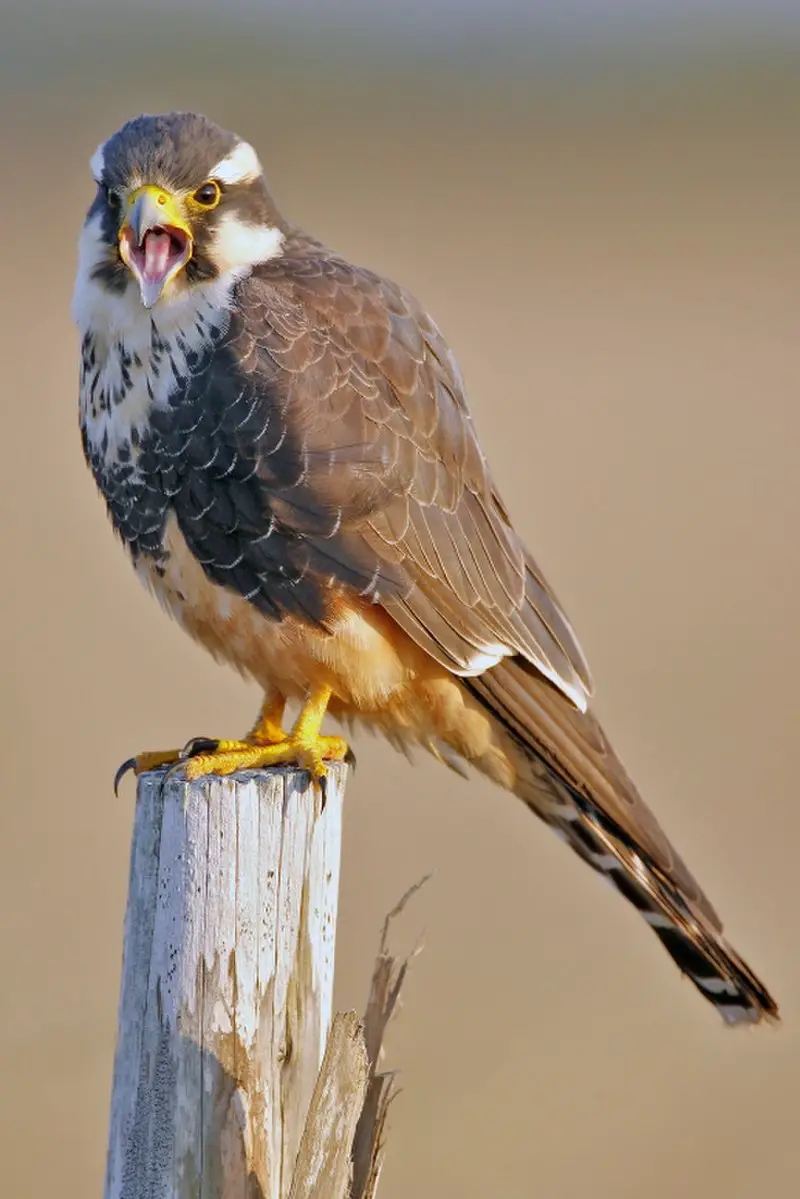
The Aplomado Falcon is a medium-sized raptor that can be found in the Americas. It has a beautiful slate grey and white plumage, with dark barring on its wings and tail.
Its long pointed wings make it an agile hunter of small birds and rodents, which it captures by flying quickly at low altitudes or swooping down from high perches.
The species’ largest range extends through South America but not into the deep Amazon Basin regions.
This falcon is sometimes mistaken for the Hobby due to their similar shape; however, they are two distinct species with different hunting behaviours and diets.Scientific classification:
| Kingdom | Animalia |
| Phylum | Chordata |
| Class | Aves |
| Order | Falconiformes |
| Family | Falconidae |
| Genus | Falco |
| Species | F. femoralis |
Also Featured In: Most Popular Bird Species in North America, Birds You’ll Find in South Texas
2. Tanagers
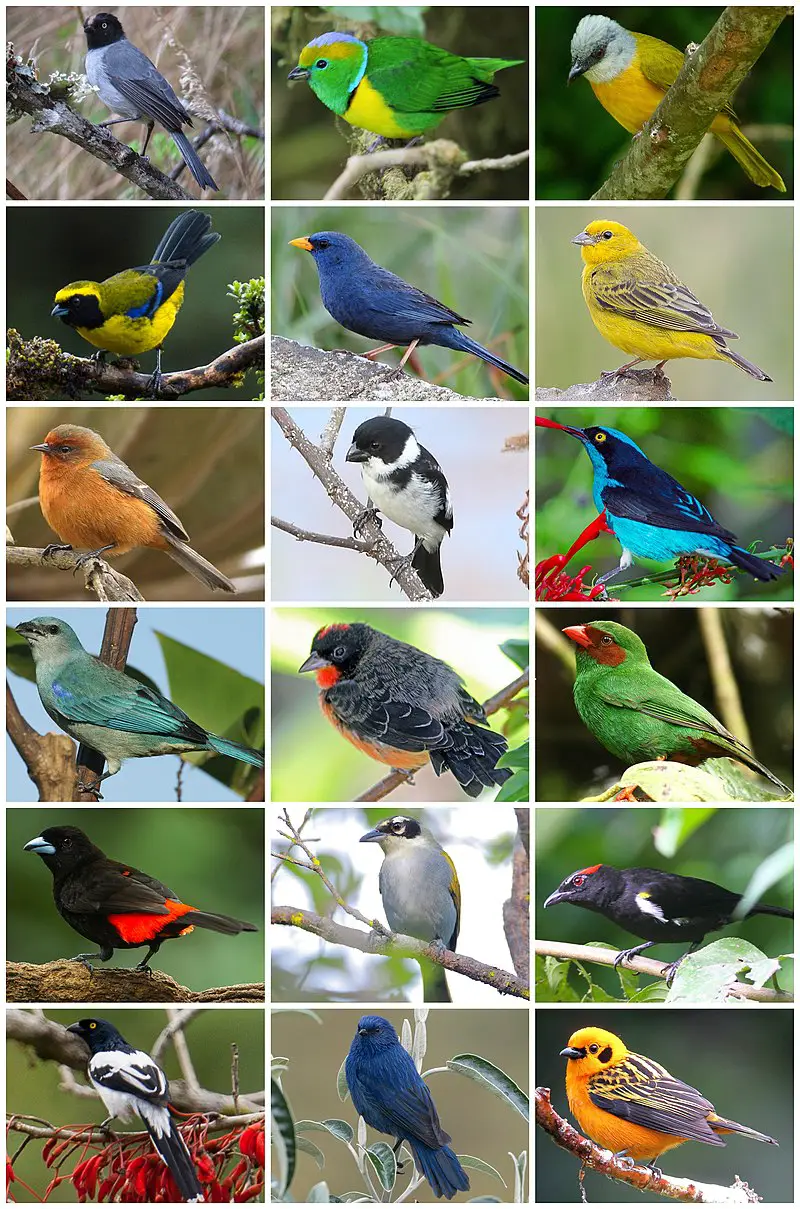
The Tanagers are a beautiful and diverse family of birds native to the Neotropical region. They boast an impressive array of colors, including blues, greens, yellows and reds.
The most common type is the fruit-eating tanager that can be found in tropical forests across Latin America. With nearly 240 species worldwide, they represent almost 4% of all avian species.
These vibrant birds have adapted well to their environment due to their strong bills used for cracking open hard fruits as well as sharp claws for gripping branches while feeding or perching.
As with many other bird families there is natural variation among populations making each one unique in its own way; something that makes them even more special.Scientific classification:
| Kingdom | Animalia |
| Phylum | Chordata |
| Class | Aves |
| Order | Passeriformes |
| Superfamily | Emberizoidea |
| Family | Thraupidae Cabanis, 1847 |
Also Featured In: Beautiful Brazilian Birds, Blue Birds You’ll Found around Us
3. Hoatzin
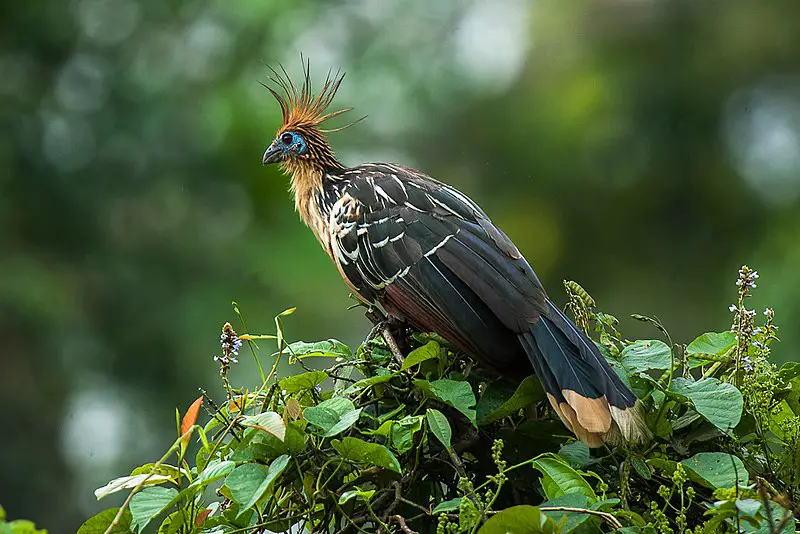
The Hoatzin bird is a tropical species found in the Amazon and Orinoco river basins of South America. It inhabits swamps, riparian forests and mangroves.
This unique bird has chicks that have claws on two of their wing digits which make it the only member in its order – Opisthocomiformes.
Its most distinctive feature is an odour produced from its digestive system which smells like cow manure.
The adults are brownish-grey with blue facial skin, red eyes, pointed crest feathers and black primaries.
They feed mainly on leaves but also eat flowers, fruits or buds when available during different seasons.
They can be heard making loud calls resembling caws at night time as well as repeated whistles throughout the day to keep contact between family members within flocks.Scientific classification:
| Kingdom | Animalia |
| Phylum | Chordata |
| Class | Aves |
| Order | Opisthocomiformes |
| Family | Opisthocomidae |
| Genus | Opisthocomus Illiger, 1811 |
| Species | O. hoazin |
Also Featured In: Birds That Live in the Jungle, Rainforest Birds You Should Know
4. Manakin
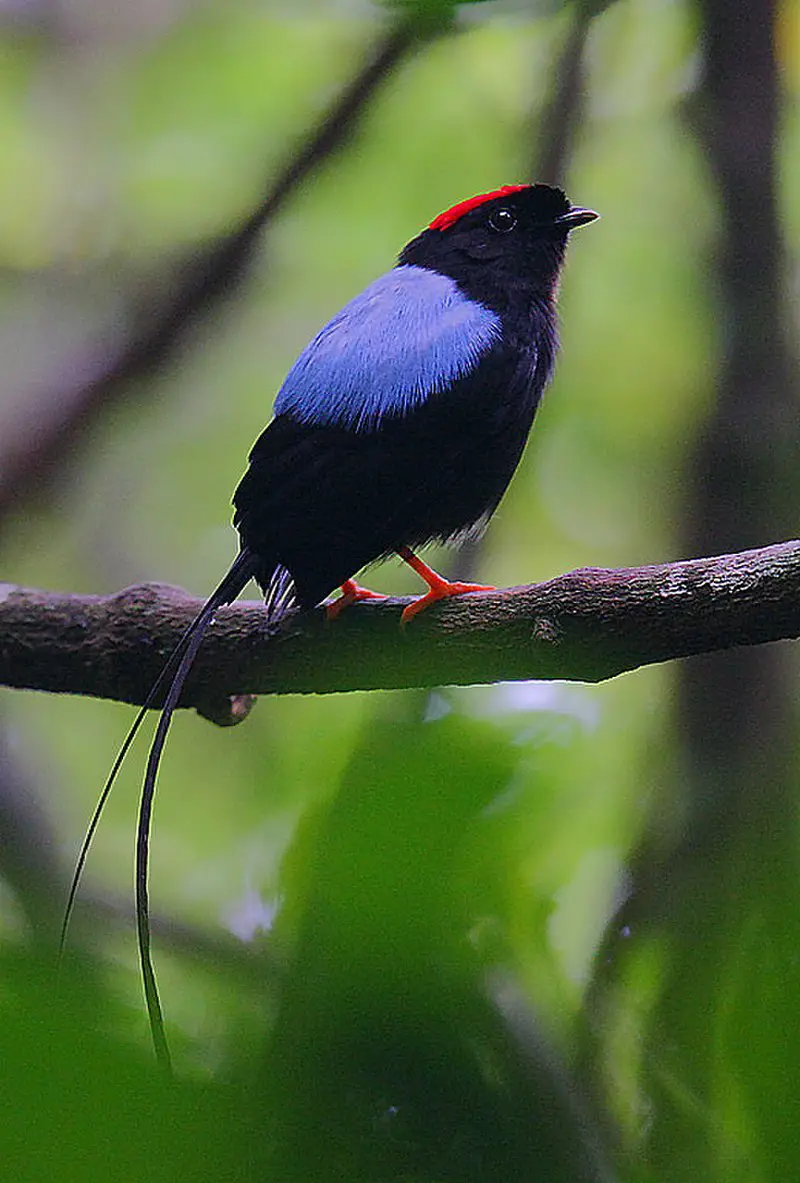
Manakins are a family of small, suboscine passerine birds found in the American tropics. They measure between 7 to 15 cm and weigh between 8-30 gm.
Some 54 species have been identified so far, all belonging to genus Tyranneutes which is characterized by their bright feather colors and unique courtship behaviors like hopping or fluttering around female manakin.
The name ‘manakin’ has its origin from Middle Dutch word ‘mannekijn’ meaning little man – aptly describing these vibrant feathered creatures.
Although they inhabit different habitats including forests, woodlands etc., some species remain threatened due to habitat destruction and fragmentation.Scientific classification:
| Kingdom | Animalia |
| Phylum | Chordata |
| Class | Aves |
| Order | Passeriformes |
| Parvorder | Tyrannida |
| Family | Pipridae Rafinesque, 1815 |
5. Jacanas
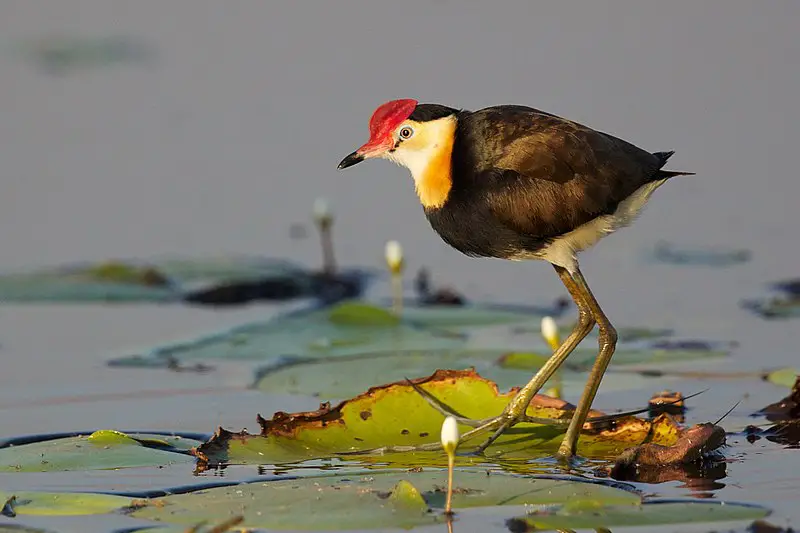
Jacanas are tropical waders belonging to the Jacanidae family. They have distinctive elongated toes and toenails which help them forage on floating or semi-emergent aquatic vegetation.
This adaptation gives them their nickname “Jesus birds” as they seem to be able to walk on water.
The female jacanas are also unique amongst bird species in that they take charge of nest building, incubation and caring for young while males perform courtship displays.
These unusual birds can be found throughout the world’s tropical regions where they inhabit wetlands such as swamps, marshes and shallow lakes with lily pads.
With a wide variety range due their special adaptations these beautiful creatures will surely continue living life at ease around our planet’s warmest waters.Scientific classification:
| Kingdom | Animalia |
| Phylum | Chordata |
| Class | Aves |
| Order | Charadriiformes |
| Suborder | Thinocori |
| Family | Jacanidae Stejneger, 1885 |
Also Featured In: Birds that You’ll Find in Puerto Rico, Birds that Charles Darwin Studied
6. Northern Storm Petrels
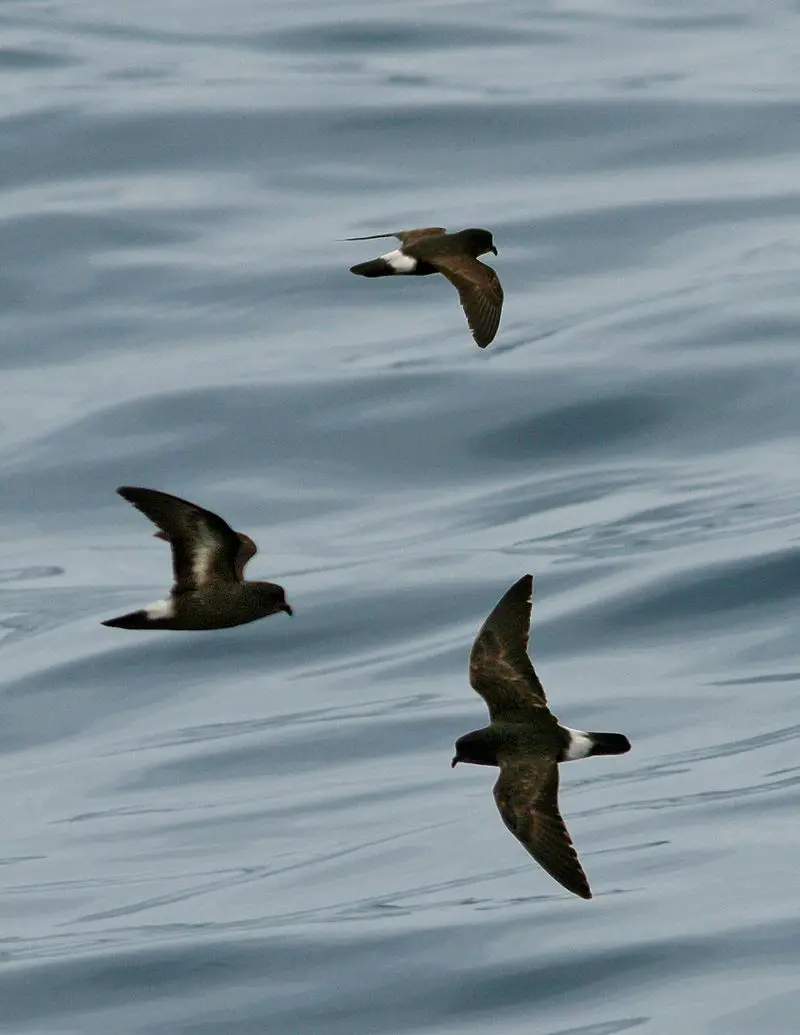
Northern storm petrels are one of the smallest seabirds, inhabiting oceans all over the world.
They have a unique ability to hover over water and pick planktonic crustaceans and small fish from the surface.
Northern storm petrels belong to the genus Hydrobates in family Hydrobatidae, part of Procellariiformes order.
This species was once lumped with austral storm petrel but recent studies show that they weren’t related closely which led them being split into two distinct species now.
These birds can be identified by their dark grey upperparts and wings along with white underparts when seen from afar while feeding on ocean’s surface.Scientific classification:
| Kingdom | Animalia |
| Phylum | Chordata |
| Class | Aves |
| Order | Procellariiformes |
| Family | Hydrobatidae Mathews, 1912 |
| Genus | Hydrobates F. Boie, 1822 |
Also Featured In: Birds You’ll Find in the Sea, Birds of Sweden
7. Heliornithidae
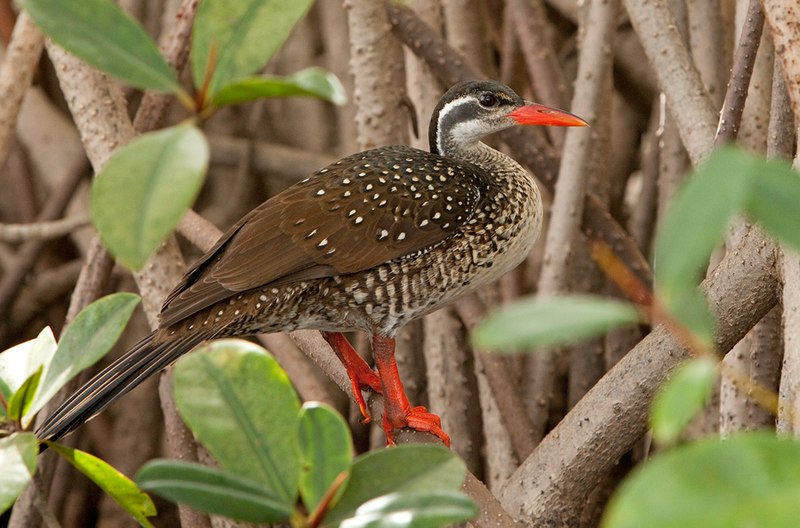
Heliornithidae, commonly known as finfoots, are a small family of tropical birds found in South America and Africa. They have webbed feet like grebes or coots, long necks, slender bodies and broad tails with sharp pointed bills.
Their diverse calls include whistles, squawks and croaks which they use to communicate with each other.
Finfoots feed mainly on fish but also consume insects such as water beetles and dragonflies near the surface of waterbodies.
They nest around rivers or lakes where there is plenty of cover from predators such as eagles or hawks.
During breeding season males can become quite territorial defending their territories against intruders by chasing them off aggressively using loud noises or even physical contact if necessary.Scientific classification:
| Kingdom | Animalia |
| Phylum | Chordata |
| Class | Aves |
| Order | Gruiformes |
| Family | Heliornithidae GR Gray, 1840 |
Also Featured In: Birds of Côte d’Ivoire, Birds that Found in Sumatra
8. Psophia
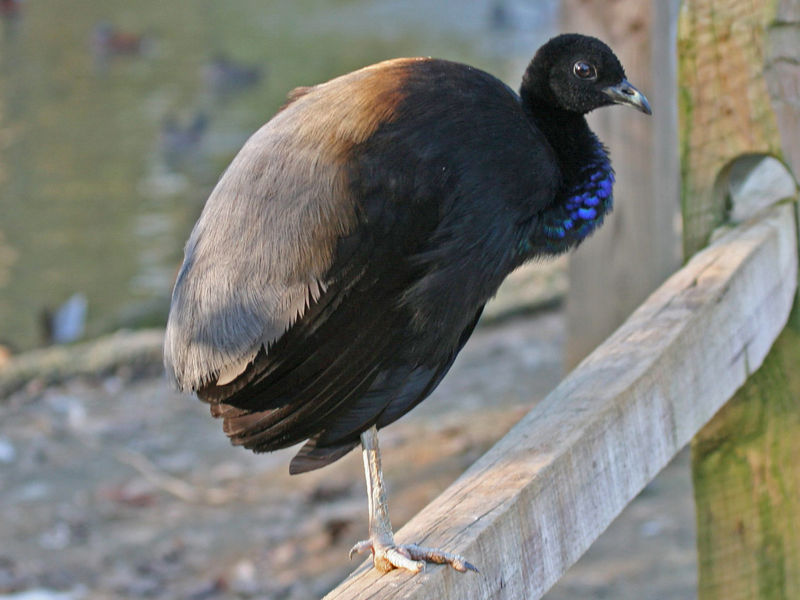
Psophia is a genus of birds found in South America, and are the only members of the Psophiidae family. They have an unmistakable appearance, with their long legs and necks giving them a chicken-like stature.
Males make loud trumpeting or cackling noises when they feel threatened. The three species range from 45 to 52 centimetres (18 to 20 inches) in length, weighing up to 1.5 kg (2 lbs).
They live mainly in humid forests across the Amazon and Guiana Shield regions, where there is plenty for them forage on such as fruit, insects and small animals like lizards or frogs.
These fascinating creatures play an important role within their environment; helping disperse seeds throughout the forest by eating fruits which contain large quantities of seeds that will eventually be spread elsewhere through defecation.Scientific classification:
| Kingdom | Animalia |
| Phylum | Chordata |
| Class | Aves |
| Order | Gruiformes |
| Family | Psophiidae Bonaparte, 1831 |
| Genus | Psophia Linnaeus, 1758 |
9. Pelecaniformes
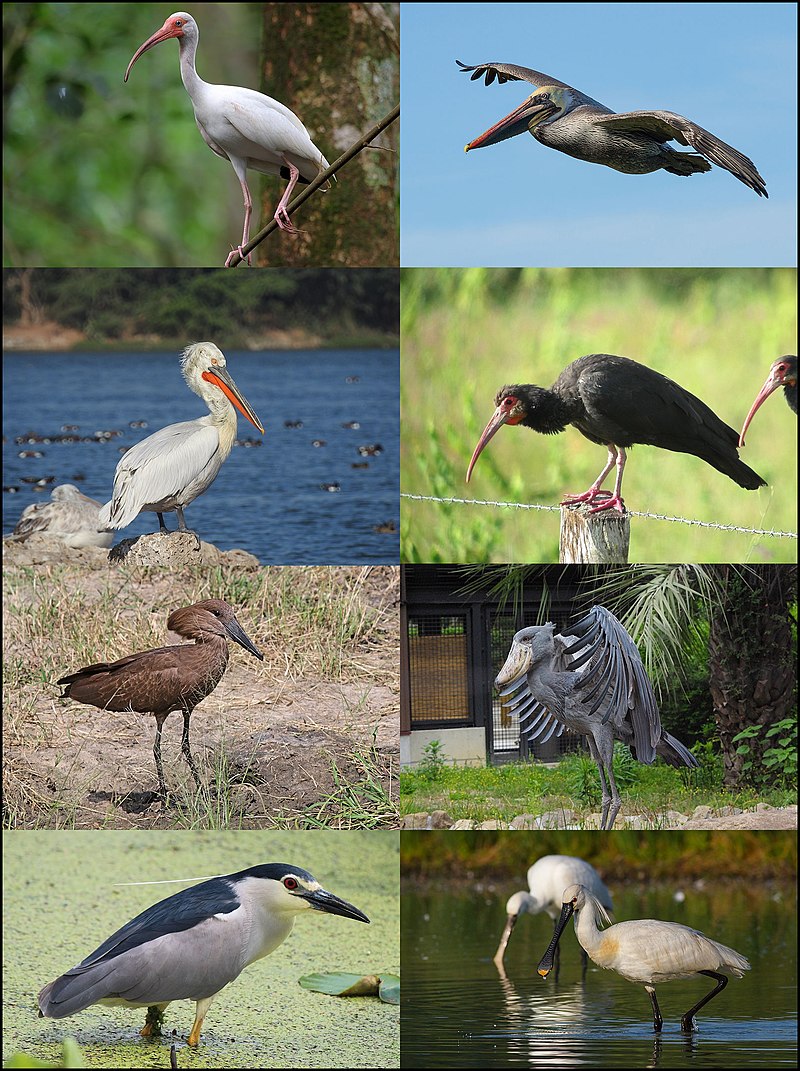
Pelecaniformes are a diverse order of waterbirds found all around the world. They vary in size, but most species are medium to large birds with webbed feet and a bare throat patch (gular patch).
Their nostrils have evolved into non-functional slits. Some examples include pelicans, gannets, cormorants and frigatebirds which can be found near coasts or on inland waters such as lakes or rivers.
Many Pelecaniforms fish for food by diving underwater from the air – some even swim underwater.
The diet of these birds consists mainly of small fishes although they may also eat mollusks, crustaceans and other aquatic creatures depending on their location.
All in all, Pelecaniformes make an important contribution to our planet’s biodiversity by keeping populations of fish under control while providing us with great views when we’re out exploring nature.Scientific classification:
| Kingdom | Animalia |
| Phylum | Chordata |
| Class | Aves |
| Clade | Aequornithes |
| Order | Pelecaniformes Sharpe, 1891 |
Also Featured In: Top Birds Found in Mexico, Common Species of Birds
10. Trogon
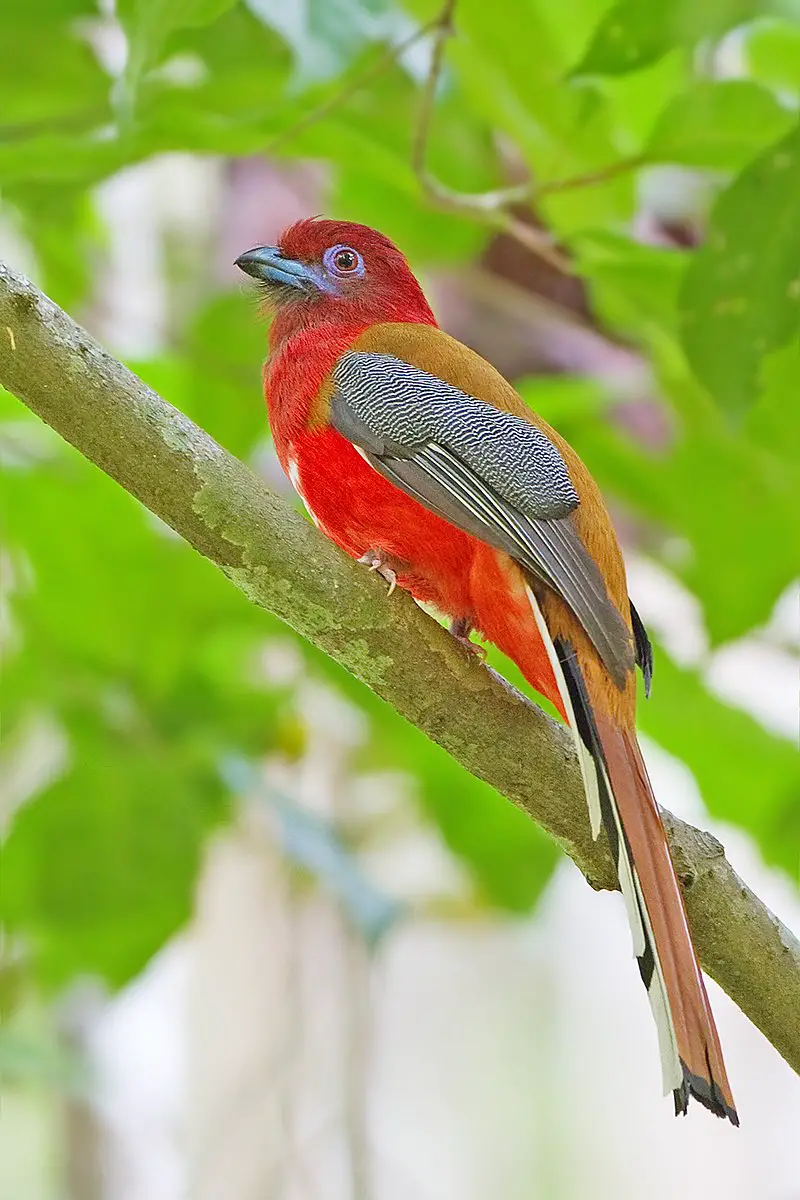
Trogons are a unique bird species that can be found all over the world. They belong to the order Trogoniformes and have only one family, called Trogonidae, which consists of 46 species in seven genera.
Fossil records show that trogons existed 49 million years ago during the Early Eocene period. It is believed they may be closely related or form part of two other orders: Coraciiformes and Passerines.
These birds typically have brightly colored feathers with some having iridescent colors on their wings and tails as well as red bellies and breasts.
Their diet mainly consists of fruit, insects, lizards and frogs but larger ones will also feed on small mammals such as mice or bats.
The most famous member from this group is Quetzalcoatlus – an extinct giant pterosaur which lived approximately 70-65 million years agoScientific classification:
| Kingdom | Animalia |
| Phylum | Chordata |
| Class | Aves |
| Clade | Cavitaves |
| Clade | Eucavitaves |
| Order | Trogoniformes AOU, 1886 |
| Family | Trogonidae Lesson, 1828 |
Also Featured In: Birds of the Philippines, Birds that Live in Borneo Island
11. Ringed Kingfisher
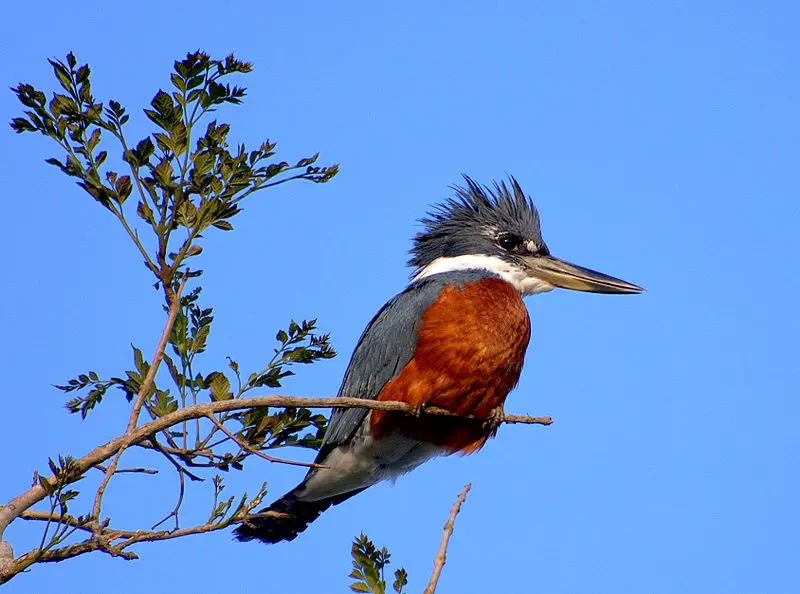
The Ringed Kingfisher is a large, vibrant bird that can be easily noticed by its loud call. It’s found in tropical regions from the lower Rio Grande Valley of southeastern Texas to Central America and even as far south as Tierra del Fuego.
This ground-dwelling species prefers to inhabit open areas near water bodies like streams, rivers and lakes which provide them with plenty of food such as fish, amphibians, crustaceans and insects.
In 1888 it was first identified by ornithologist Frank Chapman who noted its distinct ring pattern on the breast area.
The upperparts are dark blue while underneath they have white spots around their neck and belly region along with pale brown wings tipped in black stripes making this species quite unique among other kingfishers.
They may look intimidating but these birds actually play an important role for humans since they help control insect populations thus helping maintain a healthy balance within our ecosystems.Scientific classification:
| Kingdom | Animalia |
| Phylum | Chordata |
| Class | Aves |
| Order | Coraciiformes |
| Family | Alcedinidae |
| Subfamily | Cerylinae |
| Genus | Megaceryle |
| Species | M. torquata |
Also Featured In: Common Birds in Colombia, Birds You’ll Find in the Rio Grande Valley
12. Tropical Mockingbird
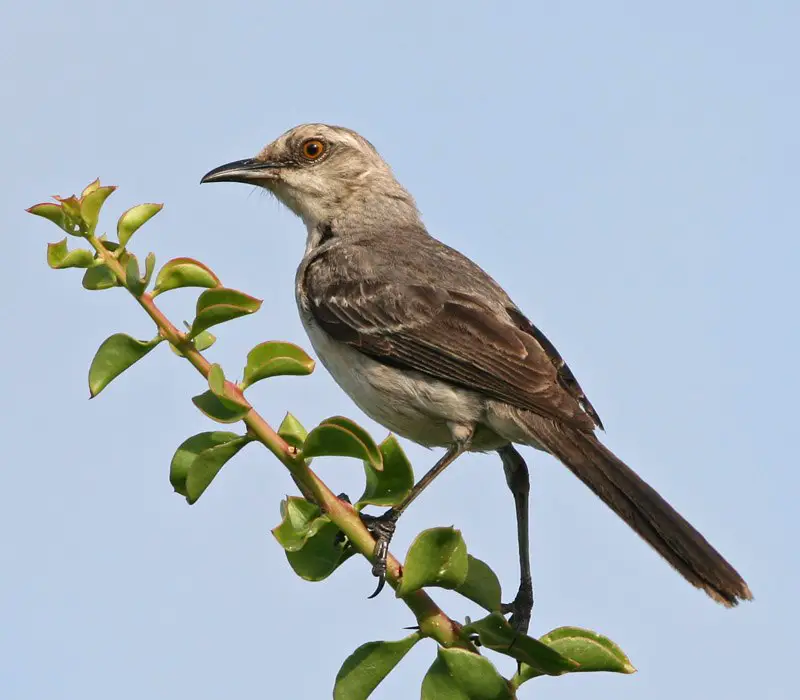
The Tropical mockingbird is a species of bird found throughout Central America and the Caribbean. It has been classified as a resident breeding bird, with its range stretching from southern Mexico to northern and eastern South America.
This species is closely related to the Northern Mockingbird, forming what is known as a superspecies between them both.
The Tropical mockingbird can be recognized by its grey-brown coloration on top, blending into white underparts which are highlighted by black spots along their throat and wings.
They have long legs for perching in trees or shrubs while searching for prey such as insects before singing out melodic songs during territorial disputes with other birds in the area.
Sadly, one subspecies -the San Cristobal Mockingbird – has been listed as critically endangered due to habitat destruction caused by human activities including logging within their natural environment.Scientific classification:
| Kingdom | Animalia |
| Phylum | Chordata |
| Class | Aves |
| Order | Passeriformes |
| Family | Mimidae |
| Genus | Mimus |
| Species | M. gilvus |
Also Featured In: Caribbean Birds, Most Common Birds You’ll Find in Quintana Roo
13. New World Barbet
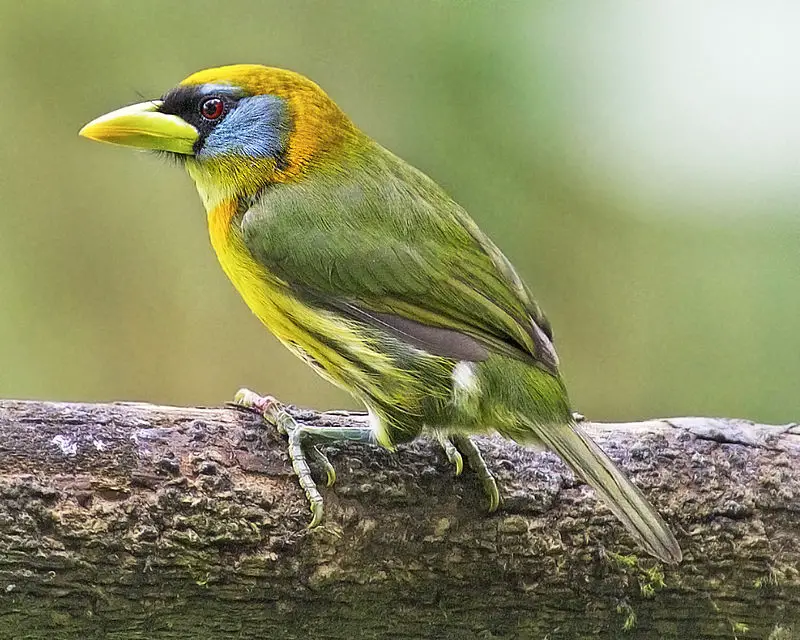
New World barbets are beautiful birds belonging to the family Capitonidae and order Piciformes, found in humid forests of Central America and South America.
They have a plump body with short necks and large heads covered by bristles around their heavy bills.
These brightly coloured creatures inhabit tropical forests, making them an exciting sight for bird watchers.
The diet of these birds mainly consists of fruits from trees such as figs or other soft-bodied insects like caterpillars which they feed on using their strong beaks.
Barbets are usually seen alone but can also form small flocks when searching for food sources together or during migration periods between different locations within the same region.
Although not much is known about New World barbet breeding habits, it has been observed that they nest in cavities formed inside tree trunks or branches close to where food sources are abundant throughout the year.
This helps ensure successful offspring growth even during harsh weather conditions experienced at times.Scientific classification:
| Kingdom | Animalia |
| Phylum | Chordata |
| Class | Aves |
| Order | Piciformes |
| Infraorder | Ramphastides |
| Family | Capitonidae Bonaparte, 1838 |
14. Rufescent Tiger Heron
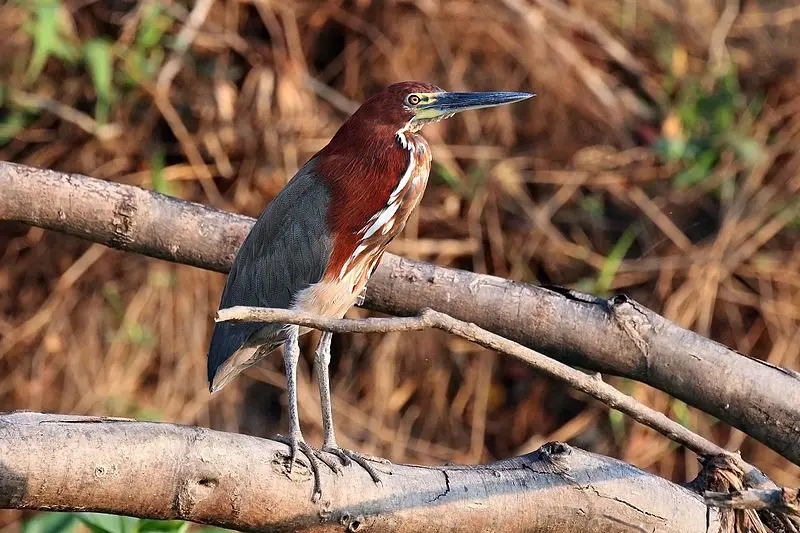
The Rufescent Tiger Heron is a species of heron found in wetlands from Central America to South America. It was first described by the French polymath Georges-Louis Leclerc, Comte de Buffon in 1780.
This majestic bird has a light brown body with dark barring on its wings and tail feathers. Its long beak curves downwards and its legs are yellowish-green.
The head is grayer than the rest of its body, giving it an almost regal appearance when seen in flight or perching atop trees near water bodies like rivers or lakes.
With their striking colours and size – reaching up to 90cm tall – they can easily stand out against other birds.Scientific classification:
| Kingdom | Animalia |
| Phylum | Chordata |
| Class | Aves |
| Order | Pelecaniformes |
| Family | Ardeidae |
| Genus | Tigrisoma |
| Species | T. lineatum |
Also Featured In: Birds of Argentina,
15. Festive Amazon
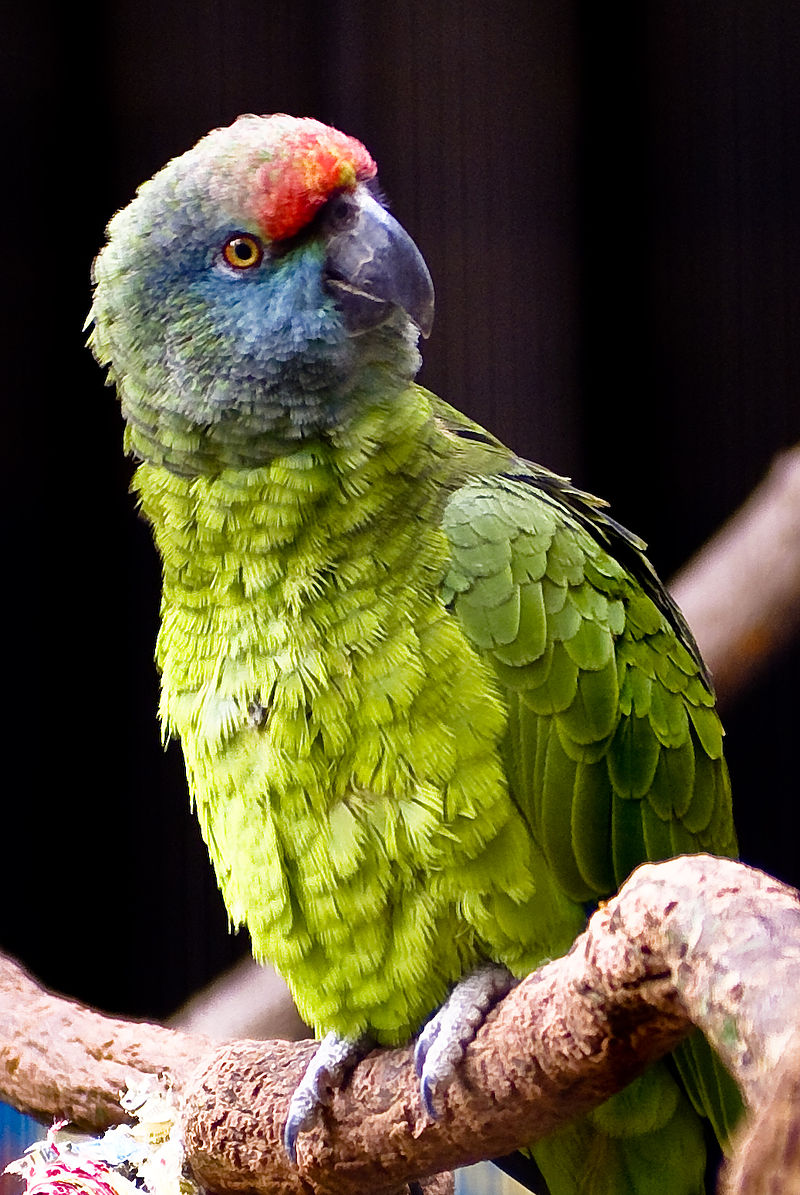
The Festive Amazon is a vibrant parrot species located in Brazil, Colombia, Ecuador, Bolivia, Guyana and Venezuela. It inhabits tropical forests near the major rivers of these countries as well as coastal mangroves in Amapá.
This beautiful bird has two subspecies – A. f festiva and A.f amazonica that differ slightly from each other in their physical characteristics such as size and plumage colouration.
The festive amazon measures between 33-35 cm long with its wingspan reaching up to 45cm , making it one of the largest parrots found in South America.
Its signature bright green feathers are complemented by yellow patches on its chest area creating an eye-catching display; truly living up to its name ‘Festive’ .Scientific classification:
| Kingdom | Animalia |
| Phylum | Chordata |
| Class | Aves |
| Order | Psittaciformes |
| Family | Psittacidae |
| Genus | Amazona |
| Species | A. festiva |
Also Featured In: Most Unique Birds in Peru,
16. Guianan Cock-Of-The-Rock
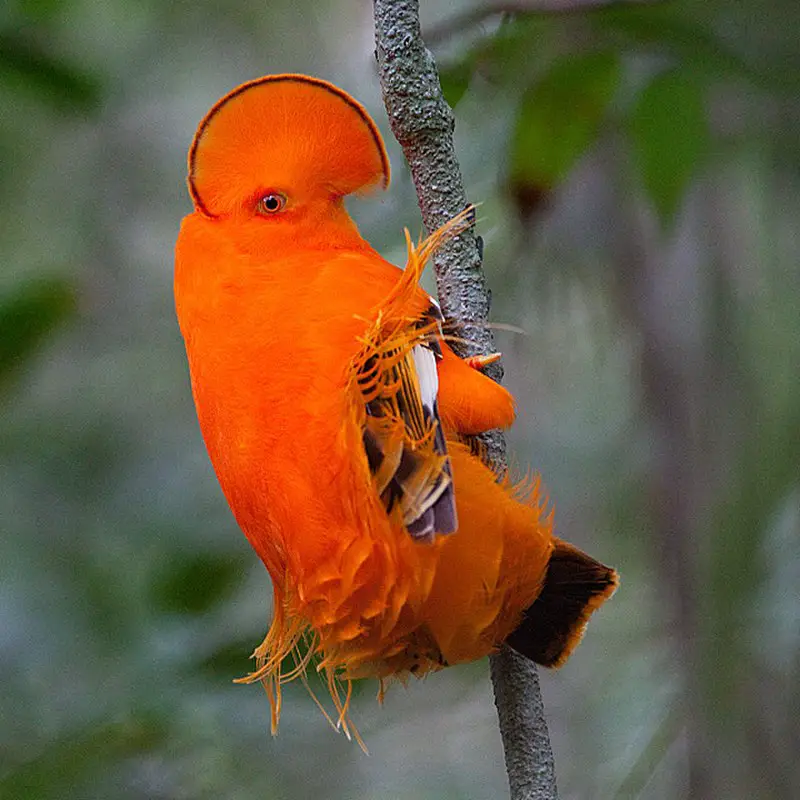
The Guianan cock-of-the-rock is an impressive South American bird, with the male having a striking orange and black plumage.
This cotinga species can be found in tropical rainforests near rocky outcrops, usually measuring about 30 cm (12 in) long and weighing around 200 to 220 g (7.1 to 7.8 oz).
The female’s feathers are brownish/dark smokey grey – generally less noticeable than the males due to their bright colours.
These birds have also been known for their unusual courtship displays involving loud calling and bowing which take place on exposed rocks or branches of tall trees.
Their diet consists mainly of fruits supplemented by invertebrates such as insects, spiders, millipedes and centipedes that they capture while flying through the canopy layer.
All in all, these beautiful creatures will make sure you never forget them after seeing one.Scientific classification:
| Kingdom | Animalia |
| Phylum | Chordata |
| Class | Aves |
| Order | Passeriformes |
| Family | Cotingidae |
| Genus | Rupicola |
| Species | R. rupicola |
Also Featured In: Birds of Venezuela, Common Tropical Rainforest Birds
17. Large-Billed Tern
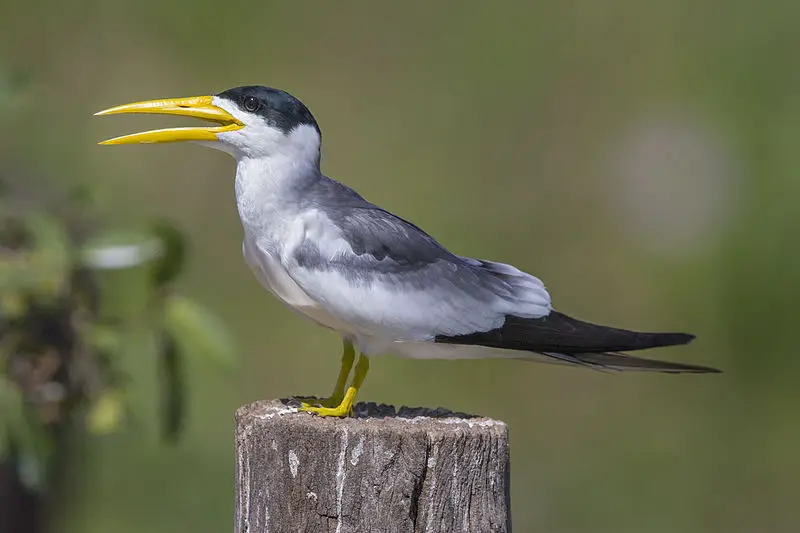
The Large-billed Tern is a species of tern found in most parts of South America. It was formally described by scientists back in 1786 and can be identified for its large bill, which it uses to feed on small fish or insects near rivers or freshwater lakes.
This bird has also been spotted as a vagrant in other countries such as Aruba, Bermuda, Cuba, Panama and the United States.
The Large-Billed Tern prefers shallow waters with plenty of vegetation around them so that they can find food easily while still providing themselves protection from larger predators.
They are quite adept at fishing using their long bills to catch prey but will also scavenge when needed.
In conclusion the Large-billed Tern is an interesting bird who plays an important role within its natural habitat.Scientific classification:
| Kingdom | Animalia |
| Phylum | Chordata |
| Class | Aves |
| Order | Charadriiformes |
| Family | Laridae |
| Genus | Phaetusa Wagler, 1832 |
| Species | P. simplex |
Also Featured In: Birds of Bolivia,
18. Lineated Woodpecker

The Lineated Woodpecker is a large bird found in Mexico, Argentina and the Caribbean. It was first described by French zoologist Mathurin Jacques Brisson in 1760 with the name Le pic noir.
This species has black upperparts, wings and tail with white stripes running along its back and head; it also features red marks on its forehead as well as on both sides of its neck.
Its underparts are mostly greyish-white while its bill is yellowish-black and slightly hooked at the end.
These birds feed mainly on insects but can sometimes be seen foraging for fruits or tree sap too.
They nest inside cavities usually made from dead trees which they excavate themselves using their strong bills perfect for drilling into woody material easily.
All in all, these beautiful birds make an interesting addition to any backyard garden.Scientific classification:
| Kingdom | Animalia |
| Phylum | Chordata |
| Class | Aves |
| Order | Piciformes |
| Family | Picidae |
| Genus | Dryocopus |
| Species | D. lineatus |
Also Featured In: Birds that You’ll Find in Chiapas, Birds that Live in Jalisco Birds
19. Nightjars
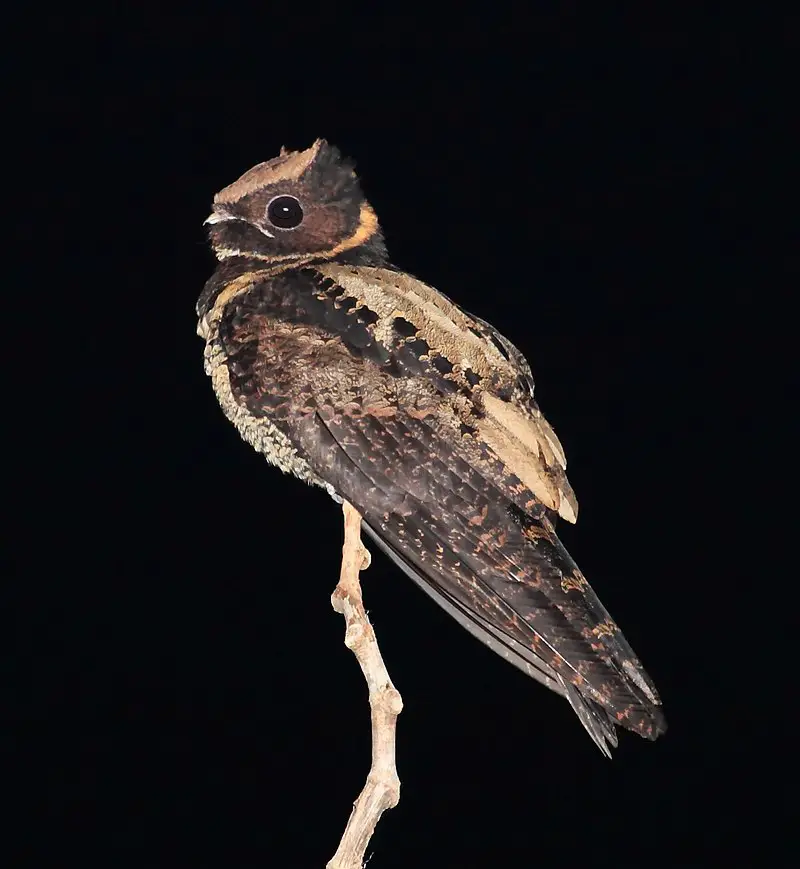
Nightjars are fascinating nocturnal or crepuscular birds belonging to the Caprimulgidae family. These medium-sized birds have long wings, short legs and very small bills.
They can be found across many parts of the world in forests, grasslands and scrubland habitats.
Nightjars feed on insects such as moths, beetles, crickets and cicadas which they catch with their sharp eyesight during night time flights over open fields when hunting for food.
Their scientific name ‘Caprimulgidae’ is derived from an old folktale that claims these birds suck milk from goats.
In reality though, they are harmless creatures who pose no threat to livestock whatsoever.
Nightjars make a variety of different calls ranging from whistles to chirps all throughout the night – adding further mystery to this amazing species.Scientific classification:
| Kingdom | Animalia |
| Phylum | Chordata |
| Class | Aves |
| Clade | Strisores |
| Order | Caprimulgiformes Ridgway, 1881 |
| Family | Caprimulgidae Vigors, 1825 |
Also Featured In: Birds of Israel, Turkey Birds You Should Know
20. Tropical Kingbird
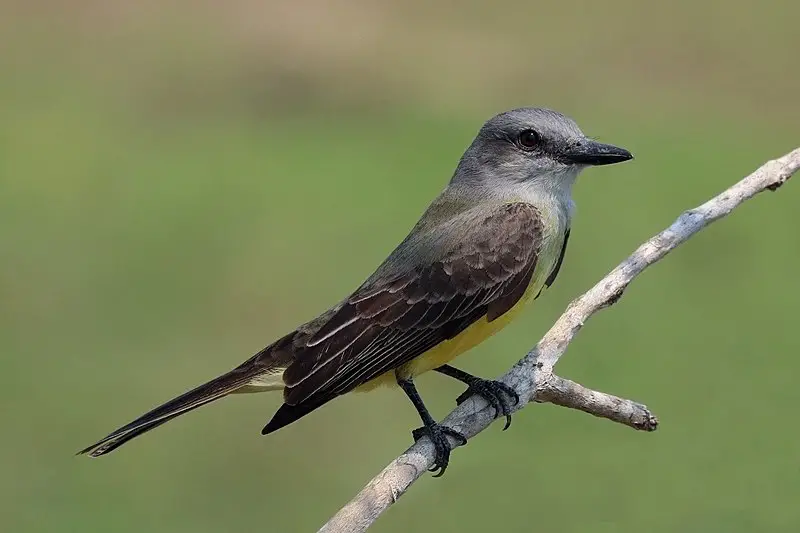
The Tropical Kingbird is an impressive bird, native to the Americas. It’s a large tyrant flycatcher that breeds in southern Arizona and Texas through Central America and down south as far as Argentina and Peru.
This species also lives on Trinidad & Tobago islands. During cold winter months, most of them migrate to warmer climates within its range.
They inhabit open areas such as fields or forests with scattered trees – but away from heavily wooded habitats.
In terms of diet, they mainly feed upon insects which are caught by hawking from perches or snatching up in flight; however it will occasionally eat fruits too.
The adult has grey-brown upperparts, darker wings edged with yellowish feathers plus a white breast band contrasting against pale orange underparts for both sexes.
A conspicuous black mask runs across their eyes completing this beautiful bird’s look.Scientific classification:
| Kingdom | Animalia |
| Phylum | Chordata |
| Class | Aves |
| Order | Passeriformes |
| Family | Tyrannidae |
| Genus | Tyrannus |
| Species | T. melancholicus |
Also Featured In: Most Common Birds In Paraguay, British Columbian Birds
21. Cotinga
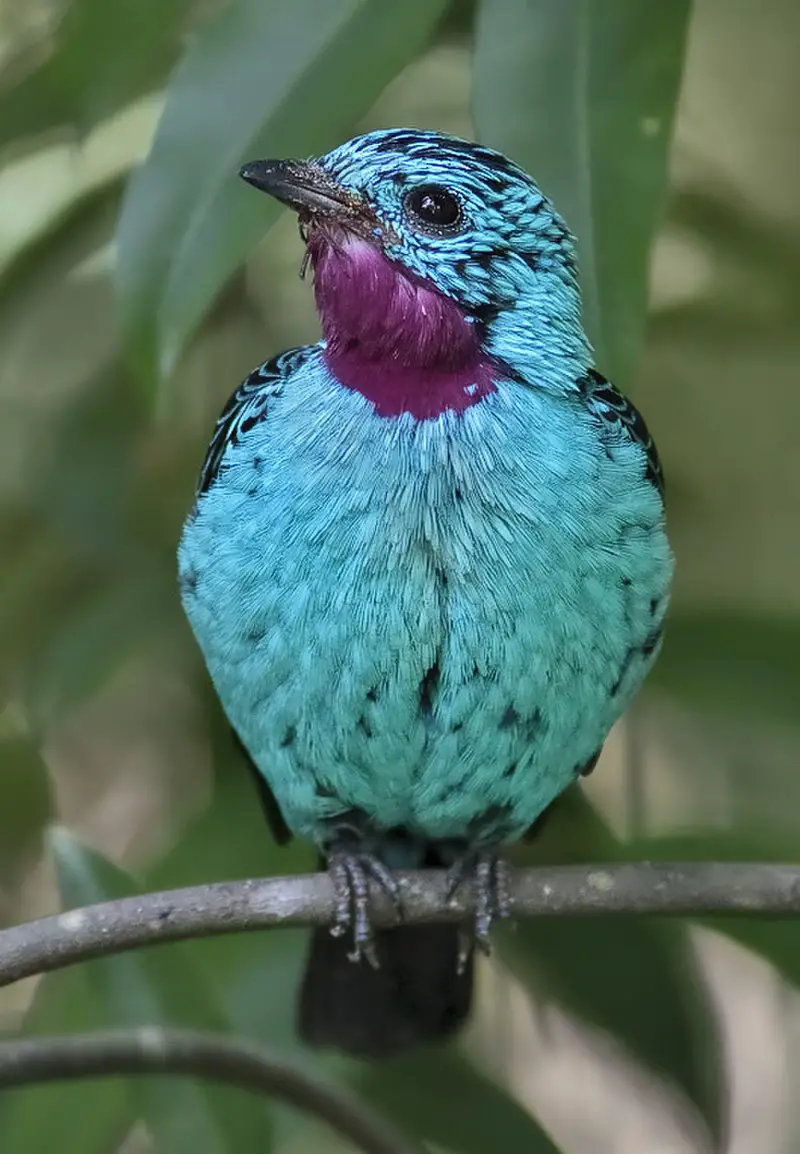
Cotingas are a large family of passerine birds that inhabit Central and South America. They have broad bills with hooked tips, rounded wings, and strong legs.
These colorful birds usually live in forests or forest edges and feed mainly on fruits. Cotinga species range from 12-13 cm (4.7–5.1 inches) to 48-51 cm long depending on the type of bird.
The fiery-throated fruiteater is among the smallest members while others like cocks -of –the rock can reach up to 51cm long.
All these birds display spectacular colors which makes them popular amongst bird watchers all over the world..Scientific classification:
| Kingdom | Animalia |
| Phylum | Chordata |
| Class | Aves |
| Order | Passeriformes |
| Parvorder | Tyrannida |
| Family | Cotingidae Bonaparte, 1849 |
Also Featured In: Costa Rica Birds,
22. Buff-Necked Ibis
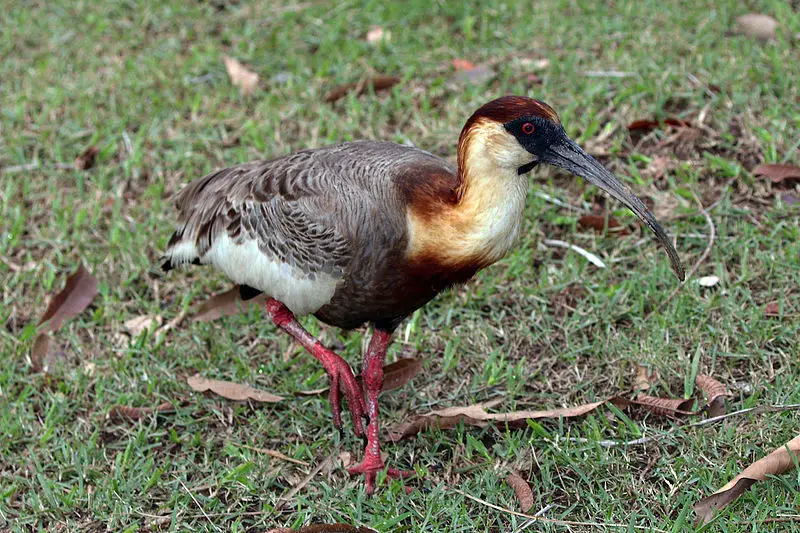
The Buff-necked Ibis is a large bird found in eastern and northern South America. It has grey plumage, with an orange beak and legs, as well as a distinctive white throat.
This striking ibis was previously considered to include the Black-faced Ibis as a subspecies but they have since been recognised as separate species.
The latter having mostly remained at colder regions of South America and featuring buff (not dark grey) lower chest feathers instead.
This bird prefers open habitats such as grasslands, savannahs or marshy areas where it feeds on small insects, lizards or other invertebrates that live among vegetation.
Despite its wide range distribution throughout much of South America this species remains vulnerable due to habitat destruction for agricultural activities which reduces their available food sources significantly.Scientific classification:
| Kingdom | Animalia |
| Phylum | Chordata |
| Class | Aves |
| Order | Pelecaniformes |
| Family | Threskiornithidae |
| Genus | Theristicus |
| Species | T. caudatus |
Also Featured In: Uruguay birds,
23. Black-Throated Mango
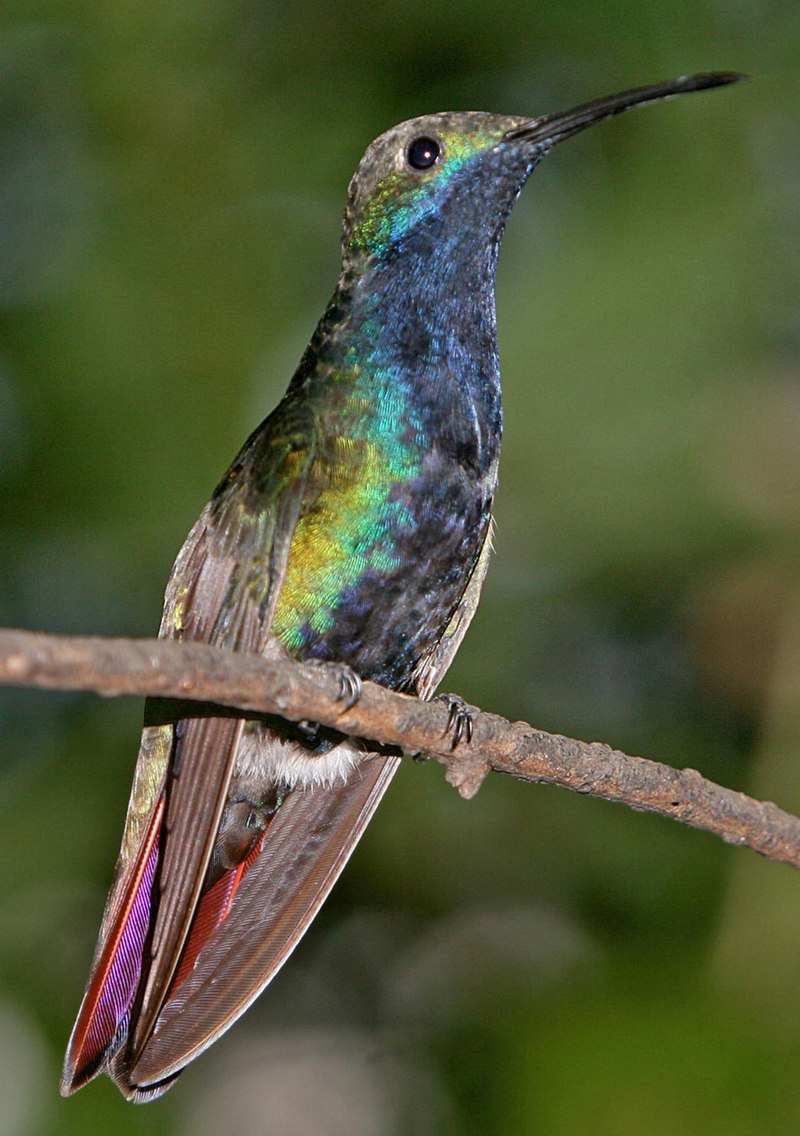
The Black-throated Mango is a beautiful species of hummingbird native to South America and Trinidad and Tobago.
It measures 10.2 cm in length, with its long black bill slightly curved at the end.
The male has bright green upperparts, while his throat and chest are matt black bordered by an iridescent golden collar on the nape area which gives it a striking appearance.
Its tail feathers have dark central ones with wine-red tips that contrast sharply with the rest of its plumage.
Females display similar features but paler than males, having greyish green upper parts without any gold or red coloration on their tails.
Despite being small in size, this bird can be easily spotted due to it’s colorful body and vibrant song.Scientific classification:
| Kingdom | Animalia |
| Phylum | Chordata |
| Class | Aves |
| Order | Apodiformes |
| Family | Trochilidae |
| Genus | Anthracothorax |
| Species | A. nigricollis |
Also Featured In: Trinidad and Tobago birds,
24. Yellow Oriole
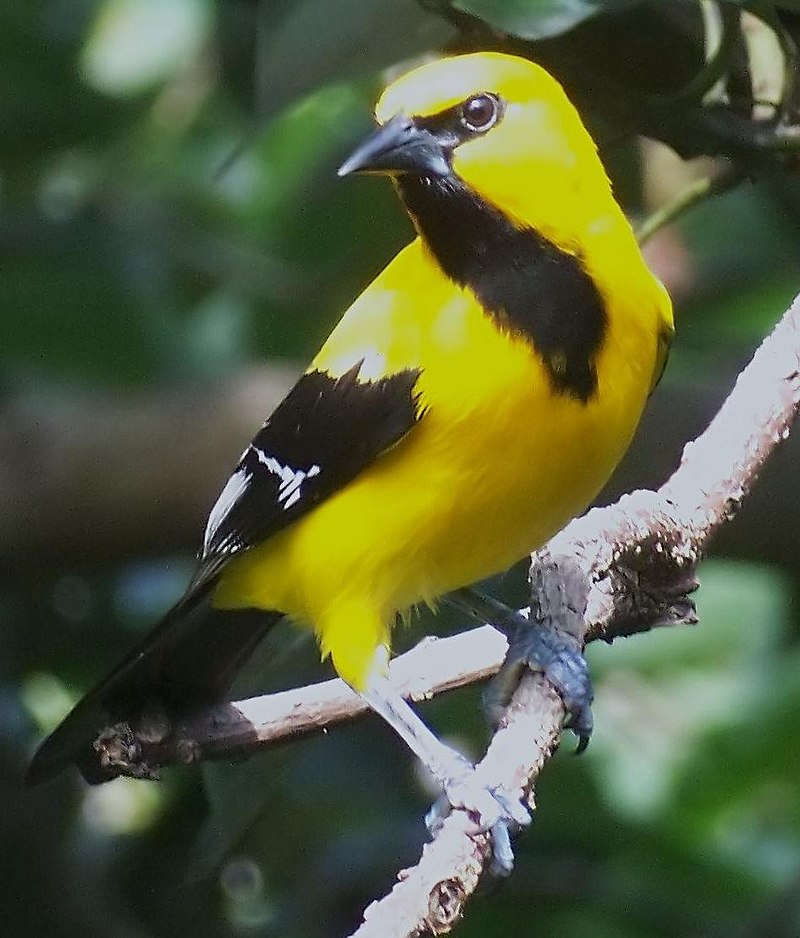
The Yellow Oriole is a beautiful passerine bird belonging to the Icteridae family. It has yellow feathers on its head, wings and back with black stripes running across them while it’s underparts are bright white in colour.
The adult male has an orange-yellow throat patch and females have grey throats.
They can be found breeding in northern South America where they inhabit dense woodland areas and open savanna habitats close to rivers or lakes.
Known as the Plantain Bird or Small Corn Bird by locals, these birds feed mainly on insects but will also consume fruits such as plantains and small corn grains for their diet. In Venezuela they’re known affectionately as ‘Gonzalito’.
A truly stunning species of wildlife worth keeping an eye out for when travelling through South America.Scientific classification:
| Kingdom | Animalia |
| Phylum | Chordata |
| Class | Aves |
| Order | Passeriformes |
| Family | Icteridae |
| Genus | Icterus |
| Species | I. nigrogularis |
Also Featured In: Common Margarita Island Birds,
25. Anhinga
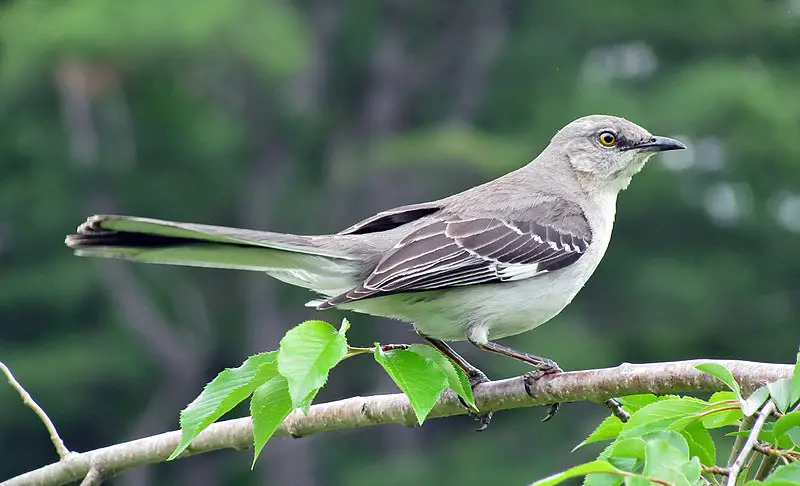
Anhinga birds are a species of water bird commonly found in tropical and subtropical climates.
They have long, slender necks that allow them to plunge their heads underwater without lifting the rest of their bodies out of the water.
Their wings are adapted for fast flight over open waters, as well as gliding on thermals. These birds also possess sharp pointed beaks which they use to spear fish and other prey beneath the surface.
Anhingas are typically black or dark brown with white patches around their eyes and neck area.
Males can reach up to 3 feet tall while females tend to be slightly smaller at 2 1/2 feet in height when fully grown.
These majestic creatures usually live near shallow wetlands where there is plenty of food such as small fishes and amphibians available for them hunt down easily
Also Featured In: Guyana birds,
26. Black Curassow
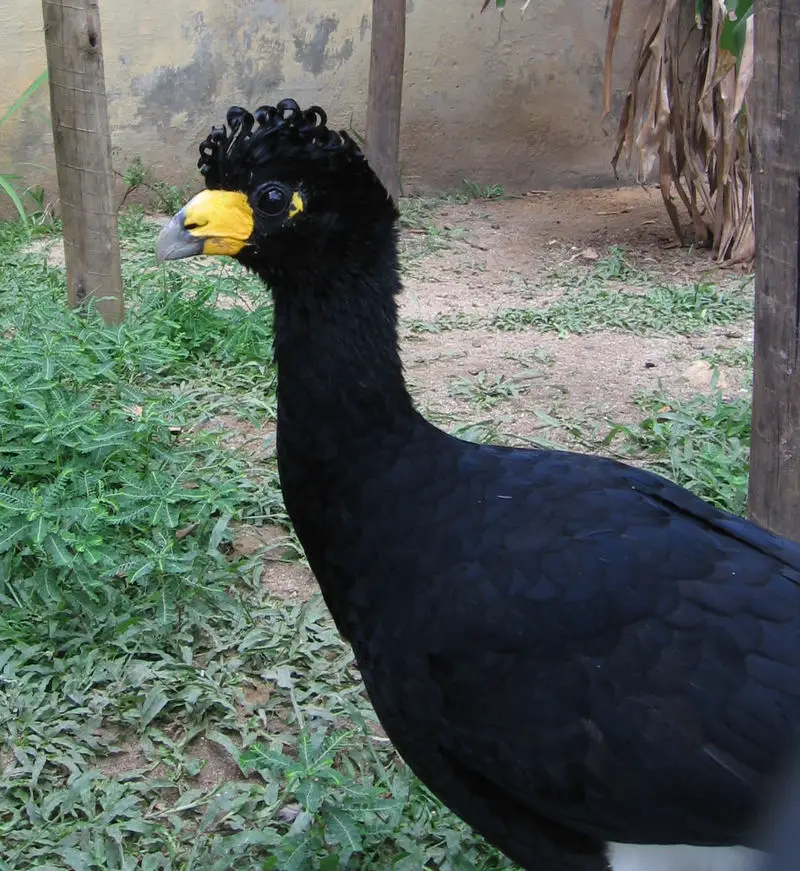
The Black Curassow is a species of bird that belongs to the Cracidae family. It inhabits humid forests in northern South America, including Colombia, Venezuela and Brazil.
This majestic bird can also be found further north on certain Caribbean islands such as Cuba, Jamaica, Haiti and Puerto Rico.
The adult has an overall black plumage with white scapulars adorning its mantle while males have a glossy blue-black head ornamented by two curved yellow casques on either side of their heads.
They are quite large birds reaching up to 75 cm (30 inches) long and weighing 2 kg (4 lbs).
Despite being hunted for food or trade purposes they remain fairly common across much of their range but due to deforestation numbers may decrease in future years .Scientific classification:
| Kingdom | Animalia |
| Phylum | Chordata |
| Class | Aves |
| Order | Galliformes |
| Family | Cracidae |
| Genus | Crax |
| Species | C. alector |
27. Green-Backed Trogon
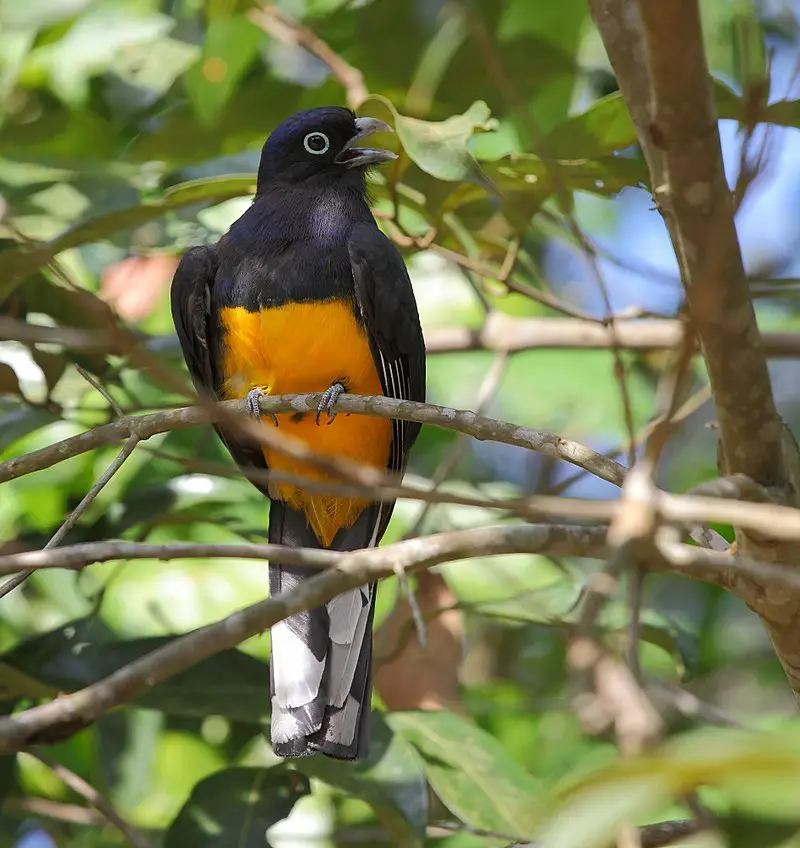
The Green-backed Trogon is a beautiful bird found in the Amazon rainforest and southeast coast of Brazil. It belongs to the trogon family, which are known for their distinct coloration.
The male has bright green upperparts with blue head that transitions into pale yellow on its belly, lacking a white breastband.
Females have brownish upperparts and olive underparts with barring throughout both sexes.
They usually feed on insects such as beetles or grasshoppers while hovering in midair before swooping down to catch prey.
This species can also be seen perched atop tree branches looking out for potential meals. Its vibrant colors make it one of most stunning birds around and an absolute must-see when visiting its natural habitat.Scientific classification:
| Kingdom | Animalia |
| Phylum | Chordata |
| Class | Aves |
| Order | Trogoniformes |
| Family | Trogonidae |
| Genus | Trogon |
| Species | T. viridis |
28. Guianan Toucanet
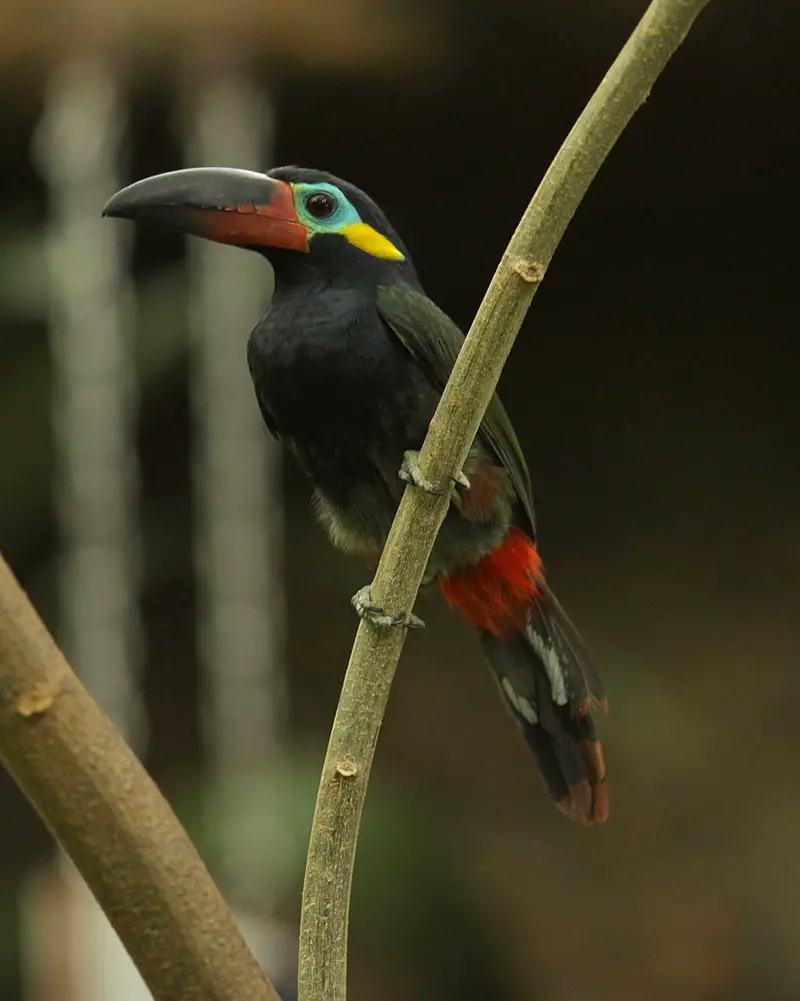
The Guianan toucanet is a colorful and unique bird that belongs to the Ramphastidae family. It can be found in Brazil, French Guiana, Guyana, Suriname and Venezuela.
This species was originally known as Ramphastos piperivorus but it has since been renamed Selenidera culik before finally achieving its current binomial name of Selenidera piperivora.
The stunning plumage of this bird consists of distinctive red markings on its forehead along with shades of black and green covering their body.
Its bill is yellowish-green with an orange stripe running down the middle which makes them quite eye catching.
They are omnivorous birds who mostly feed upon fruits like figs or berries but they also enjoy insects such as beetles or cicadas from time to time too.Scientific classification:
| Kingdom | Animalia |
| Phylum | Chordata |
| Class | Aves |
| Order | Piciformes |
| Family | Ramphastidae |
| Genus | Selenidera |
| Species | S. piperivora |
29. Guianan Warbling Antbird
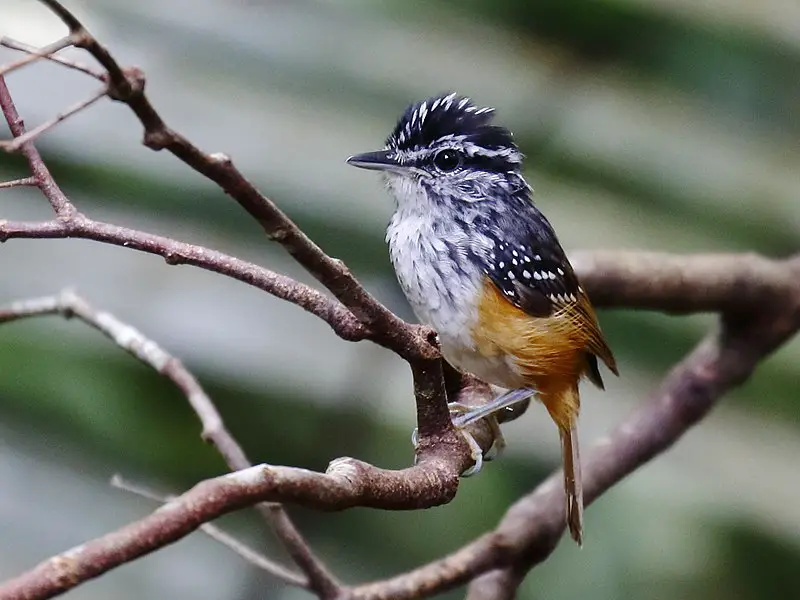
The Guianan Warbling Antbird is a species of insectivorous bird found in the humid forests of the Guiana’s, Venezuela and north-eastern Brazil.
It was first described by French polymath Georges-Louis Leclerc, Comte de Buffon, who noted its distinctive warble song which it uses to announce itself and mark territory.
The antbird has drab brown upperparts with off white underparts that contrast sharply against darker wings when in flight.
Its diet consists primarily of small insects such as ants, beetles and grasshoppers but will also feed on nectar from various flowering plants.
Its population numbers are believed to be stable at present though deforestation remains an ongoing threat for this species in addition to hunting pressures across parts of its range.Scientific classification:
| Kingdom | Animalia |
| Phylum | Chordata |
| Class | Aves |
| Order | Passeriformes |
| Family | Thamnophilidae |
| Genus | Hypocnemis |
| Species | H. cantator |
30. Green-Tailed Jacamar
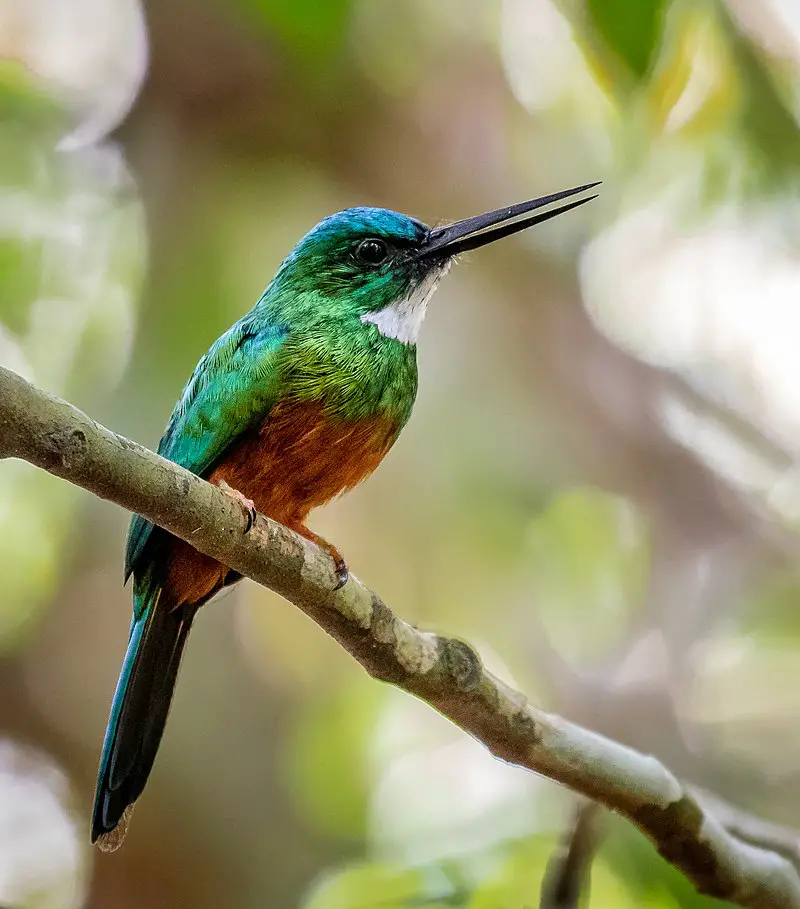
The Green-tailed Jacamar is a stunning species of bird, native to Brazil, Colombia, French Guiana, Guyana Suriname and Venezuela.
It belongs to the Galbulidae family and can be recognized by its vibrant green plumage on top with buff underparts.
Additionally it has a bright red bill that stands out against its otherwise dull colors. This monotypic species is closely related to five other jacamars; rufous-tailed, white-chinned bluish fronted and coppery chested which all form an impressive supergroup of birds known as the Picazuro group.
The Green Tailed Jacamar usually hunts high in trees for insects while they fly but may also hunt from branches or even hovering over water like kingfishers do.
They are quite secretive birds so you’ll need sharp eyesight if you’re hoping to catch sight of one.Scientific classification:
| Kingdom | Animalia |
| Phylum | Chordata |
| Class | Aves |
| Order | Piciformes |
| Family | Galbulidae |
| Genus | Galbula |
| Species | G. galbula |
31. Cocoi Heron
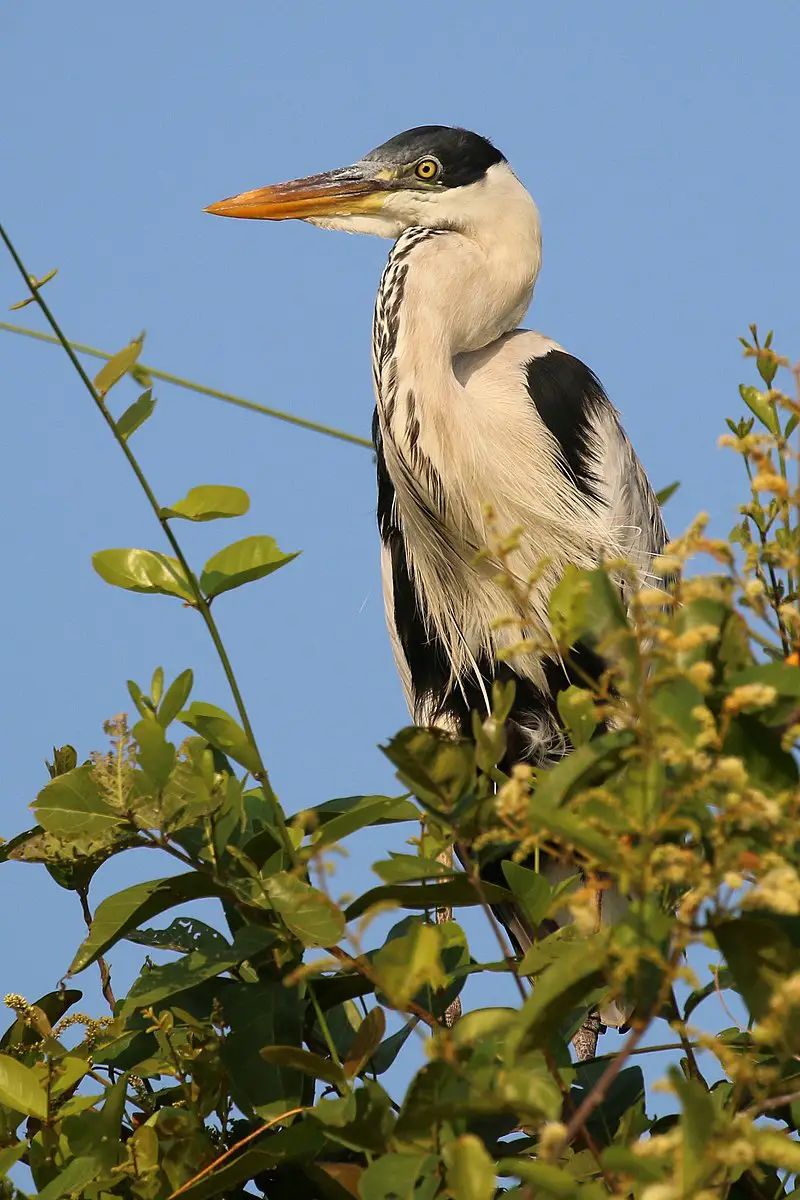
The Cocoi Heron is a majestic wading bird found in South America. It has a distinctive pale grey plumage and darker grey crest, making it easily recognizable among other herons.
This carnivore hunts for fish and crustaceans in shallow water with its long legs, giving the appearance of gracefulness even while feeding.
The origin of this species’ name remains unknown despite being first described by Carl Linnaeus back in 1766 as part of his 12th edition Systema Naturae publication.
The Cocoi Heron continues to captivate onlookers today due to its elegant beauty and remarkable hunting skills.Scientific classification:
| Kingdom | Animalia |
| Phylum | Chordata |
| Class | Aves |
| Order | Pelecaniformes |
| Family | Ardeidae |
| Genus | Ardea |
| Species | A. cocoi |
32. Black Nunbird
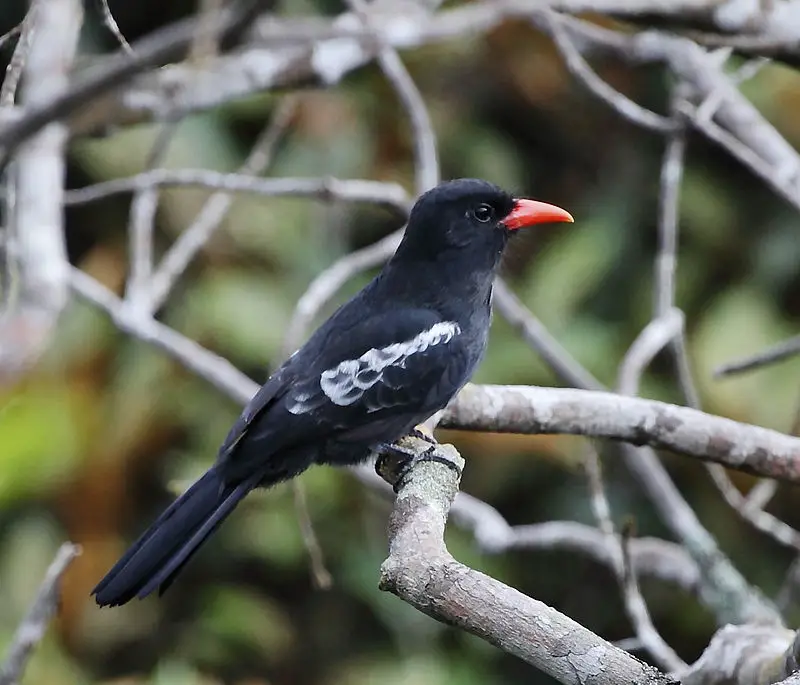
The Black Nunbird is an incredible species of near-passerine bird in the Bucconidae family. It inhabits Brazil, French Guiana, Guyana Suriname and Venezuela and was first described by Georges-Louis Leclerc in 1780.
This gorgeous creature has a distinct black plumage with white spots along its wings, back and head that make it easily recognizable among other birds.
Its diet consists mostly on fruits seeds but also small insects like beetles or caterpillars which it forages from trees during the day time.
The female will build her nest high up in tree cavities where she will lay two eggs to incubate them until they hatch after about 16 days of parental care. A beautiful sight to witness.Scientific classification:
| Kingdom | Animalia |
| Phylum | Chordata |
| Class | Aves |
| Order | Piciformes |
| Family | Bucconidae |
| Genus | Monasa |
| Species | M. atra |
33. Black-Collared Swallow
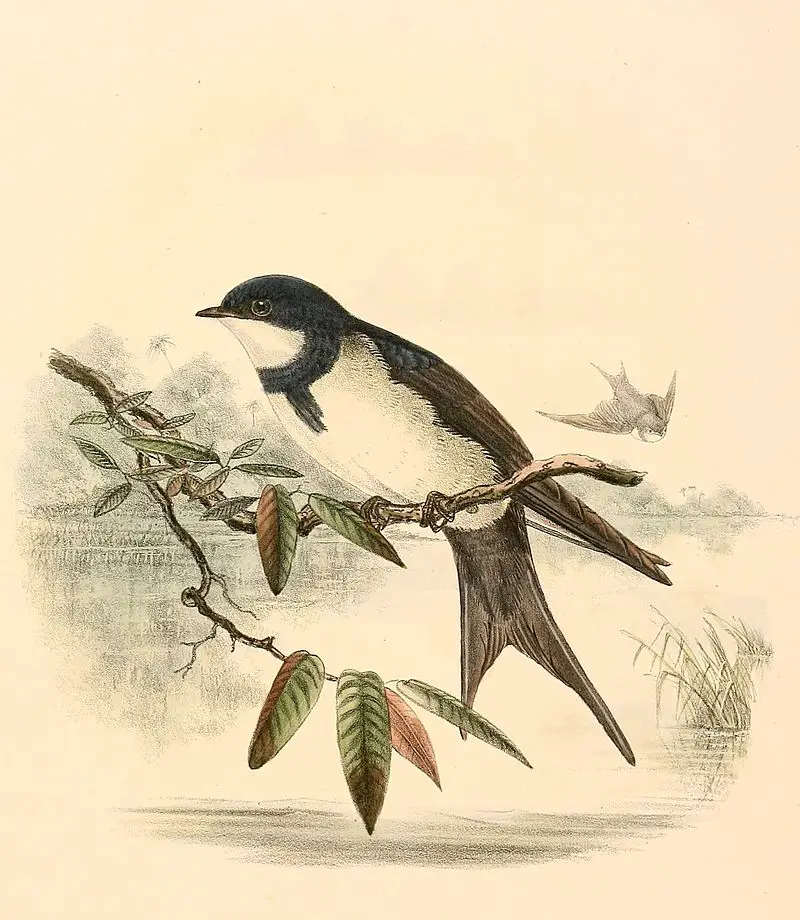
The black-collared swallow is a species of bird that can be found in South America, mainly around rivers.
It has been classified as part of the Hirundinidae family and was previously placed in the genus Atticora until a 2005 phylogenetic study moved it to the resurrected Pygochelidon genus.
This small brownish or greyish colored bird grows up to 15 cm long with its wingspan reaching 23 cm wide.
Its tail is forked, giving them an elegant appearance while flying through their natural habitat – rivers – looking after food such as insects which they scoop out from mid air during flight.
These birds are social animals often forming large flocks when searching for food or migrating together; making them quite visible on a beautiful summer day.Scientific classification:
| Kingdom | Animalia |
| Phylum | Chordata |
| Class | Aves |
| Order | Passeriformes |
| Family | Hirundinidae |
| Genus | Pygochelidon |
| Species | P. melanoleuca |
34. Finsch’s Euphonia
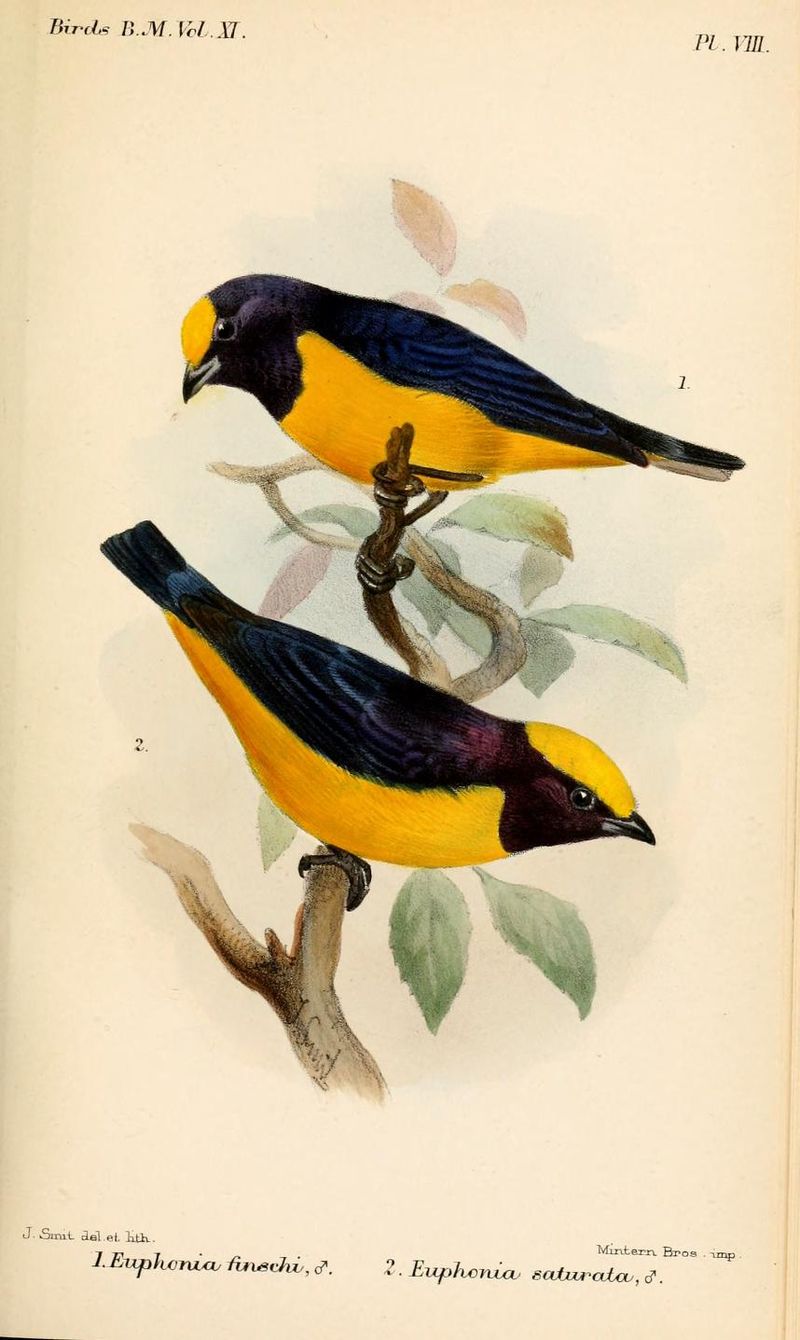
Finsch’s euphonia is a species of bird in the Fringillidae family, found in northern Brazil, French Guiana, Guyana, Suriname and eastern Venezuela.
It inhabits subtropical or tropical moist lowland forests as well as heavily degraded former forest areas.
The common name and scientific name commemorate German ethnographer Friedrich Herm Finsch.
This small songbird has an olive-green upper body with some yellow on its wings and tail feathers; it also has a black face mask that wraps around to form a “V” shape near its throat.
Its belly is pale greyish-white while its beak is dark brownish-black with white stripes running along both sides at the base of the lower mandible.
The Finsch’s Euphonia sings sweetly throughout much of their range during breeding season providing delightful music to nearby listeners.Scientific classification:
| Kingdom | Animalia |
| Phylum | Chordata |
| Class | Aves |
| Order | Passeriformes |
| Family | Fringillidae |
| Subfamily | Euphoniinae |
| Genus | Euphonia |
| Species | E. finschi |
35. Rusty-Margined Flycatcher
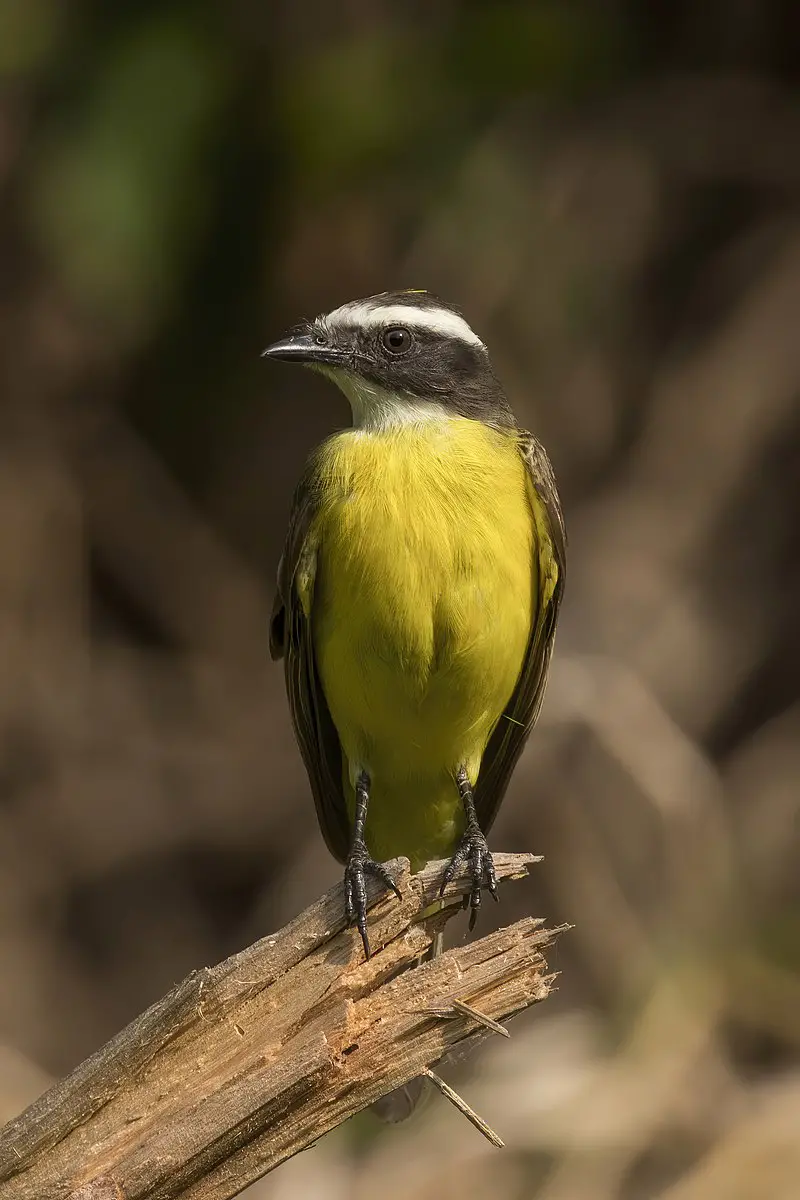
The Rusty-margined Flycatcher is a species of bird found in northern and central South America, from Bolivia to Venezuela. It also resides in eastern Panama.
This small flycatcher prefers subtropical or tropical moist lowland forests as well as heavily degraded former forest for its habitat.
Its diet consists mainly of insects that it catches midair while flying around the canopy layer; however, they will occasionally eat fruit when available too.
The rusty-margined flycatcher has an olive green back with rusty wings and tail feathers; males have black heads while females are brownish grey above their eyes and white below them instead.
This medium sized songbird is considered not threatened by IUCN but populations may be declining due to deforestation activities in some areas where these birds reside.Scientific classification:
| Kingdom | Animalia |
| Phylum | Chordata |
| Class | Aves |
| Order | Passeriformes |
| Family | Tyrannidae |
| Genus | Myiozetetes |
| Species | M. cayanensis |
36. White-Winged Swallow
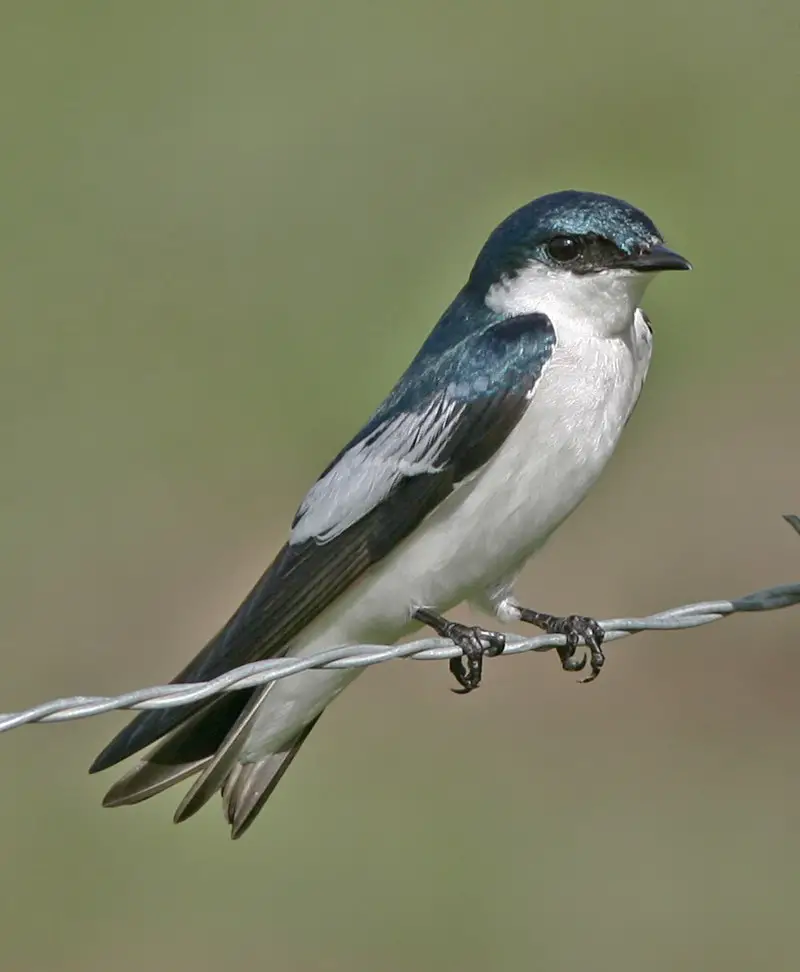
The White-winged Swallow is a small, brown bird with distinctive white patches on its wings and tail feathers. It can be found in tropical South America from Colombia to Argentina, but not west of the Andes.
These birds are mainly non-migratory and live in open habitats such as fields or grasslands.
The species was first described by Georges-Louis Leclerc in 1780 and they feed mostly on insects which they typically catch while flying low over water bodies or vegetation.
They build their nests near cliff faces where there is plenty of protection from predators such as hawks and owls.
With their beautiful plumage, these swallows make for interesting sights when spotted soaring gracefully through the air.Scientific classification:
| Kingdom | Animalia |
| Phylum | Chordata |
| Class | Aves |
| Order | Passeriformes |
| Family | Hirundinidae |
| Genus | Tachycineta |
| Species | T. albiventer |
37. Red-Capped Cardinal
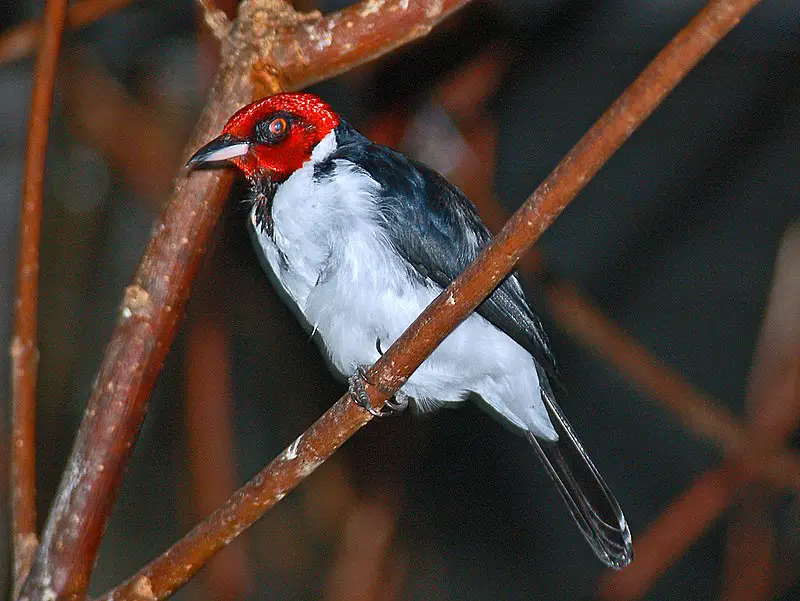
The Red-capped Cardinal is a delightful small bird found throughout South America. It has bright red plumage on its head, neck and chest which makes it stand out amongst the other birds of the same family Thraupidae.
This species was first described by French zoologist Mathurin Jacques Brisson in 1760 who named it “Le cardinal d’Amérique” or ‘Cardinalis am’.
The bird generally feeds on insects and fruits but may also consume seeds and nectar from flowers.
They form flocks for their protection when moving about looking for food sources like ants, termites or beetles among others.
During mating season males become more colourful with brighter colours than usual as they try to attract female counterparts through courtship displays involving singing duets between pairs perched high up in trees such as palm fronds or branches of shrubs near water courses.Scientific classification:
| Kingdom | Animalia |
| Phylum | Chordata |
| Class | Aves |
| Order | Passeriformes |
| Family | Thraupidae |
| Genus | Paroaria |
| Species | P. gularis |
38. Pale-Vented Pigeon
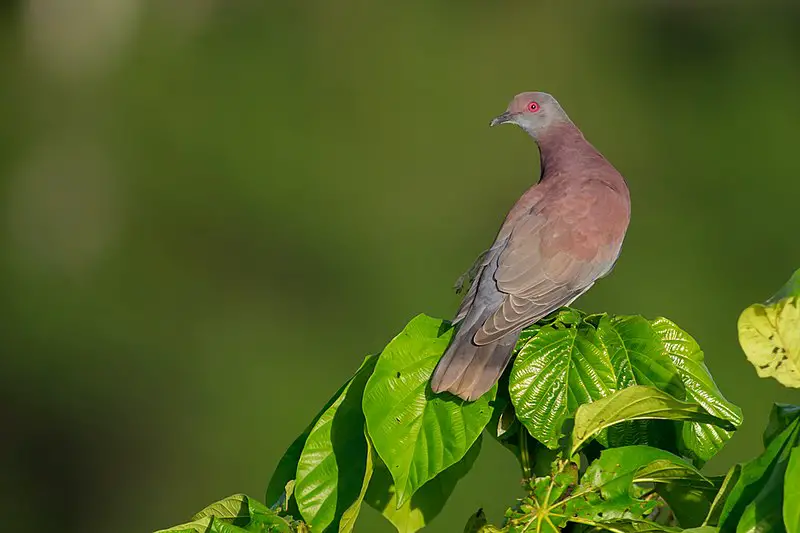
The Pale-vented pigeon is a large bird found in the tropical Americas, and belong to an evolutionary radiation of Patagioenas.
It has a grey hue all over its body, even males usually lack any iridescent colors in their plumage.
They have small heads with red eyes and short bills, while their wings are broad but pointed at the tips. Their legs are dark pink and they feed mainly on fruits from trees or shrubs.
These birds live in pairs or families throughout lightly wooded areas like pastures where they can find food easily.
However during winter months they tend to form larger flocks together for protection against predators as well as cold weather conditions.Scientific classification:
| Kingdom | Animalia |
| Phylum | Chordata |
| Class | Aves |
| Order | Columbiformes |
| Family | Columbidae |
| Genus | Patagioenas |
| Species | P. cayennensis |
Also Featured In: Birds that Live in Tabasco,
39. Palm Tanager
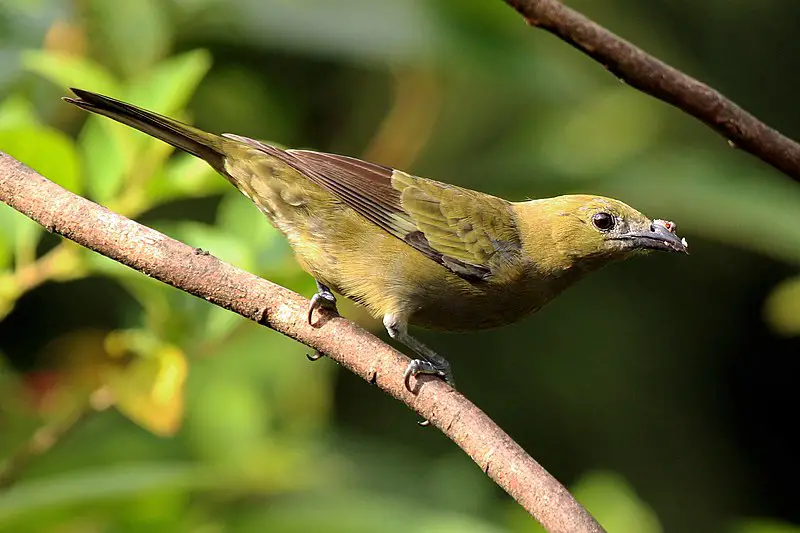
The Palm Tanager is a medium-sized passerine bird that breeds across Central and South America, from Nicaragua to Bolivia. It can also be found on the islands of Trinidad and Tobago since 1962.
This colorful tanager has a yellow head, green back and wings, grey chest and belly with black streaks, red rump feathers as well as blue flight feathers.
Its diet consists mainly of insects but it will feed on fruits too when they are available in its habitat which includes forests edges, woodland clearings an shrubland areas near water sources.
The Palm Tanagers have one brood per year consisting of 3 – 5 eggs laid directly onto the ground or low branches without any nest material being used for nesting purposes.Scientific classification:
| Kingdom | Animalia |
| Phylum | Chordata |
| Class | Aves |
| Order | Passeriformes |
| Family | Thraupidae |
| Genus | Thraupis |
| Species | T. palmarum |
Also Featured In: Suriname birds,
40. Silver-Beaked Tanager

The Silver-beaked Tanager is a medium sized passerine bird native to South America. It has an unmistakable deep crimson head and velvety black body, making it a colorful addition to any environment.
Its 18 cm length and 25g weight are typical of its family; they are usually found in pairs or small flocks near open areas with trees for perching.
The tanager’s diet consists mainly of fruit and insects, which can be caught by hawking from the air or gleaned from foliage on the ground.
This species breeds throughout most of tropical South America east of the Andes Mountains, including Venezuela, Colombia, Peru and Brazil all the way down to Paraguay as well as Trinidad island off northern coast.
With their bright colors and easy presence around human habitation these birds make excellent subjects for amateur photographers.Scientific classification:
| Kingdom | Animalia |
| Phylum | Chordata |
| Class | Aves |
| Order | Passeriformes |
| Family | Thraupidae |
| Genus | Ramphocelus |
| Species | R. carbo |
Also Featured In: Silver Birds You Should Know,
41. Anhinga
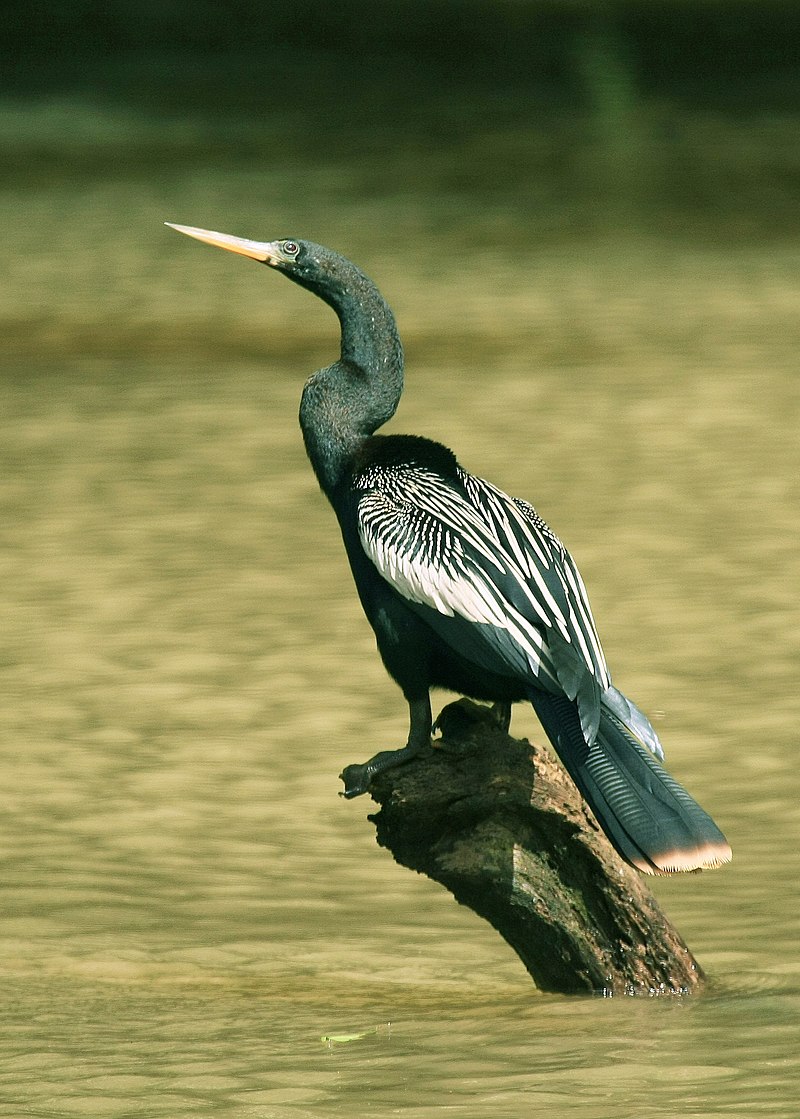
The Anhinga is a water bird found in the warmer parts of the Americas. It is sometimes called the snakebird, American darter, or water turkey.
The bird’s name comes from the Brazilian Tupi language and means “devil bird” or “snake bird.” When swimming, only the Anhinga’s neck appears above water, giving the appearance of a ready-to-strike snake.
It is a skilled swimmer and hunter, using its sharp beak to catch fish underwater. The Anhinga is easily recognizable by its long neck, sharp beak, and distinctive coloring of black and white feathers.
Its ability to dry its wings quickly after diving is unique among water birds, as it lacks the natural oils that make feathers waterproof.
The Anhinga is an important member of its ecosystem, helping to control fish populations and serving as prey for larger predators.Scientific classification:
| Kingdom | Animalia |
| Phylum | Chordata |
| Class | Aves |
| Order | Suliformes |
| Family | Anhingidae |
| Genus | Anhinga |
| Species | A. anhinga |
Also Featured In: Water Birds Live around Us, Everglades Birds
42. Flamingos
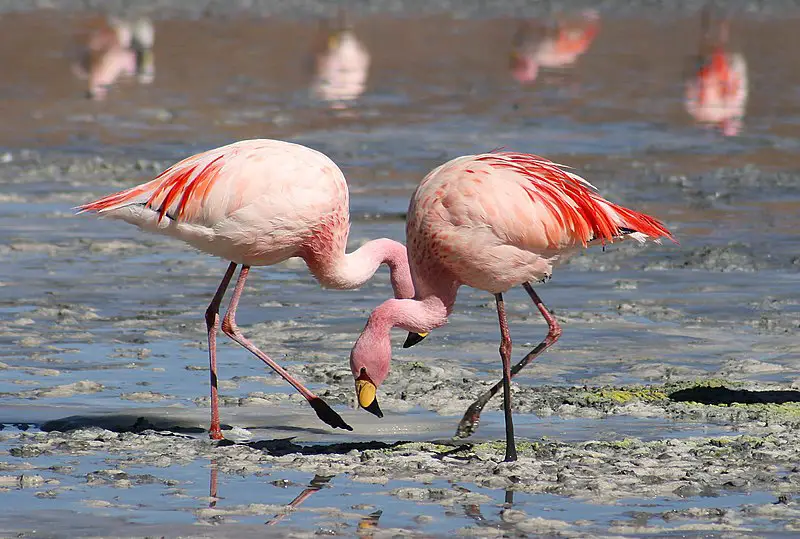
Flamingos are a type of water bird that belong to the Phoenicopteriformes group. They are known for their distinctive pink coloring and long, thin legs.
Flamingos are closely related to grebes and are part of the Mirandornithes clade. These birds are well-documented in the fossil record, with some of their extinct relatives dating back millions of years.
In fact, the first known member of the Phoenicopteridae family was a bird called Elornis. Flamingos are known for their unique feeding habits, which involve using their beaks to filter food from the water.
They are also social creatures that typically live in large groups called colonies.
Overall, flamingos are fascinating creatures with a long history on our planet.Scientific classification:
| Kingdom | Animalia |
| Phylum | Chordata |
| Class | Aves |
| Clade | Mirandornithes |
| Order | Phoenicopteriformes Fürbringer, 1888 |
Also Featured In: Common Algerian Birds , Most Common Romanian Birds
43. Antbird
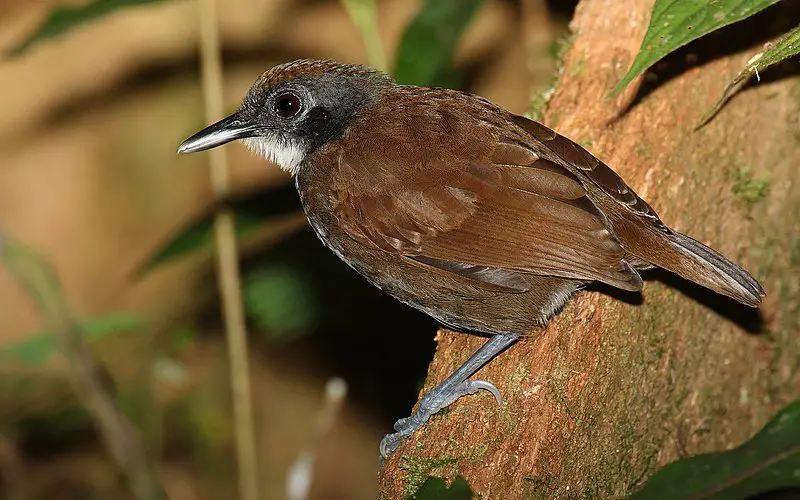
Antbirds are passerine birds found in Central and South America. They belong to the Thamnophilidae family, which includes over 230 species known by different names such as antshrikes, antwrens, antvireos, fire-eyes, bare-eyes, and bushbirds.
They are closely related to antthrushes, antpittas, tapaculos, gnateaters, and ovenbirds. These birds have varied appearances and live in subtropical and tropical regions.
They feed on insects, spiders, and other invertebrates, and some species participate in mixed-species flocks for added protection from predators.
The antbird’s habitat includes humid forests, savannas, and shrublands. These birds play a crucial role in maintaining ecosystem balance and are crucial to the food chain.Scientific classification:
| Kingdom | Animalia |
| Phylum | Chordata |
| Class | Aves |
| Order | Passeriformes |
| Parvorder | Furnariida |
| Family | Thamnophilidae Swainson, 1824 |
Also Featured In: Most Common Birds in South America Birds,
44. Orange-Breasted Falcon
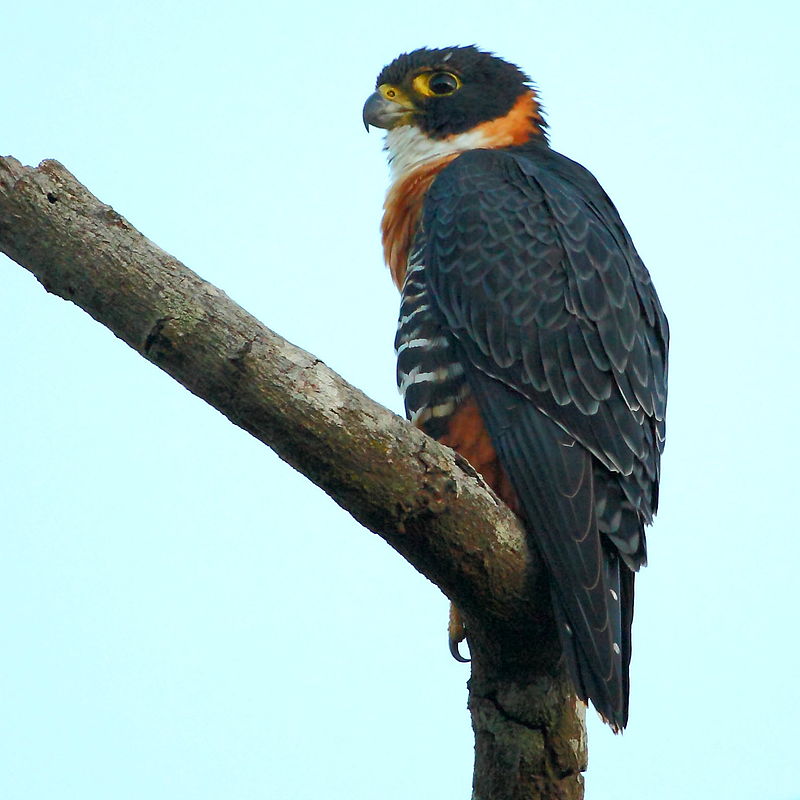
The Orange-breasted falcon is a bird of prey belonging to the Falconidae family. It is found in Central and South America, but its population is decreasing, making it a Near Threatened species.
This falcon shares similarities in plumage and vocalizations with the Bat falcon. It has a distinctive orange-colored breast and feeds on small mammals, birds, and reptiles.
The Orange-breasted falcon is an important predator in its ecosystem and helps to control pest populations.
Despite its importance, habitat loss and hunting are contributing to its decline, and conservation efforts are needed to preserve this species.Scientific classification:
| Kingdom | Animalia |
| Phylum | Chordata |
| Class | Aves |
| Order | Falconiformes |
| Family | Falconidae |
| Genus | Falco |
| Species | F. deiroleucus |
45. Amazonian Umbrellabird
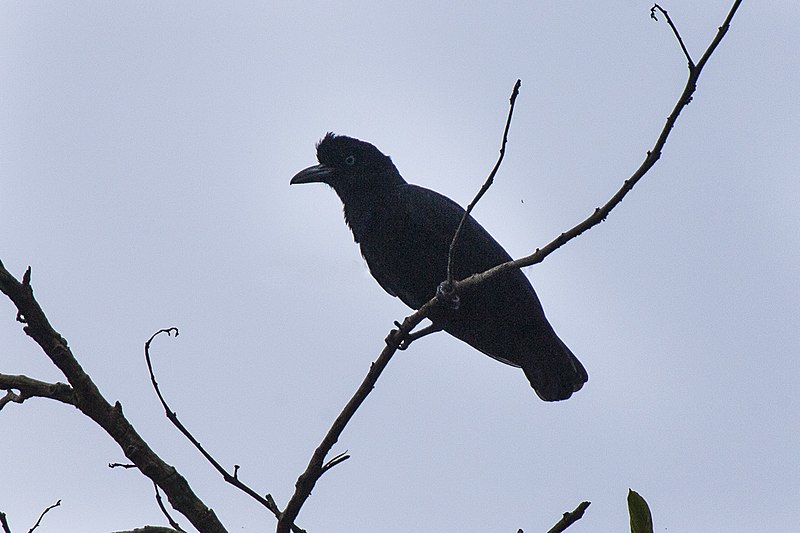
The Amazonian umbrellabird is an impressive species of bird found in the Amazon basin and on the eastern slopes of the Andes.
The male bird is entirely black and stands out with its black crest and inflatable wattle on the throat.
It can reach a length of up to 55 cm and may be the largest passerine bird in South America. The female is slightly smaller in size, but still impressive.
This bird belongs to the family Cotingidae and is known for its unique appearance.
It is a species that is important to conserve, as they are vulnerable due to habitat loss and hunting.
The Amazonian umbrellabird plays an important role in the ecosystem and is a favorite amongst birdwatchers who are lucky enough to see them in their natural habitat.Scientific classification:
| Kingdom | Animalia |
| Phylum | Chordata |
| Class | Aves |
| Order | Passeriformes |
| Family | Cotingidae |
| Genus | Cephalopterus |
| Species | C. ornatus |
46. Blue-Naped Chlorophonia
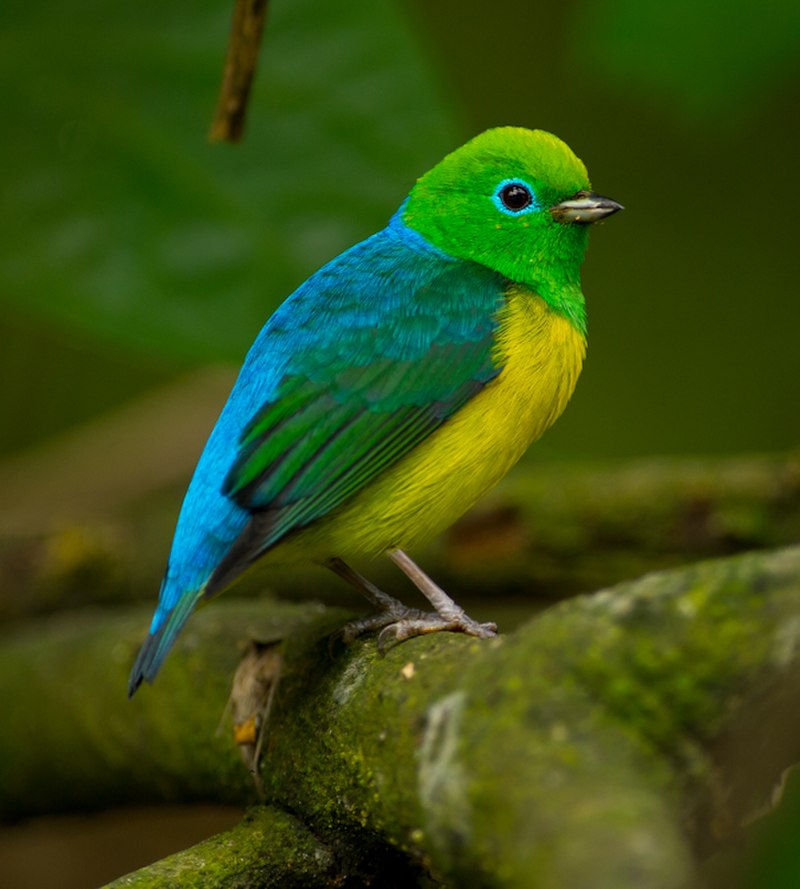
The Blue-naped chlorophonia is a vibrant bird native to South America, belonging to the Fringillidae family.
It is easily recognizable by its predominantly green plumage, with a bright yellow underbelly and a blue lower nape, mantle, rump, and eye-ring.
Some subspecies also have a yellow frontlet. Though small and plump, this bird is relatively common. Interestingly, male individuals are brighter and more colorful than females.
The Blue-naped chlorophonia’s habitat consists of humid forests and cloud forests, where it feeds on fruits and insects.
Its bold coloration is believed to play a role in mate selection and territorial display.
Overall, this bird is a beautiful example of the unique and diverse wildlife found in South America.Scientific classification:
| Kingdom | Animalia |
| Phylum | Chordata |
| Class | Aves |
| Order | Passeriformes |
| Family | Fringillidae |
| Subfamily | Euphoniinae |
| Genus | Chlorophonia |
| Species | C. cyanea |
47. Guianan Streaked Antwren
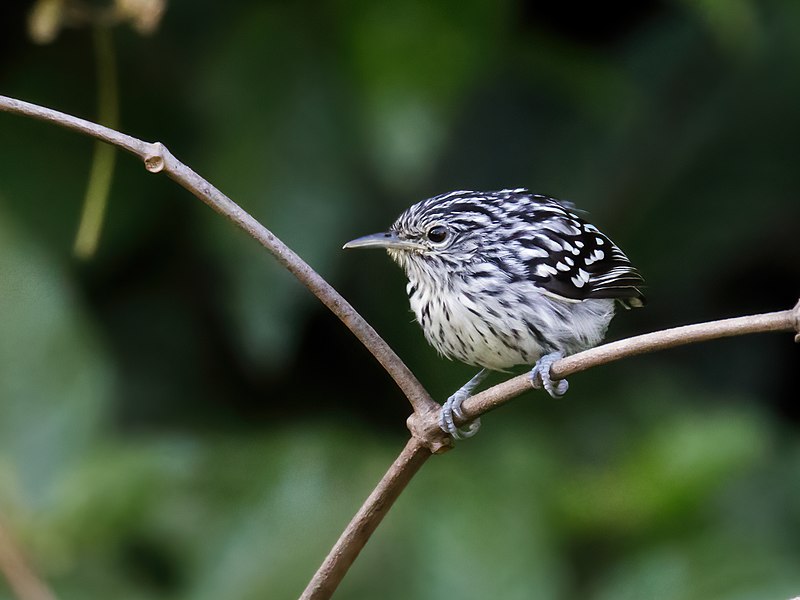
The Guianan streaked antwren is a small bird found in subtropical or tropical forests, swamps, and degraded former forests in South America.
Its black and white streaked feathers and the female’s rufous-cinnamon head and buff underparts distinguish it.
This species belongs to the family Thamnophilidae and is known for its insectivorous diet.
Unfortunately, like many other bird species, its natural habitats are threatened due to deforestation and habitat loss.
Consequently, conservation measures should be taken to protect and preserve this bird species and their natural habitats.Scientific classification:
| Kingdom | Animalia |
| Phylum | Chordata |
| Class | Aves |
| Order | Passeriformes |
| Family | Thamnophilidae |
| Genus | Myrmotherula |
| Species | M. surinamensis |
48. White-Plumed Antbird

The white-plumed antbird is a small bird that inhabits the rainforests’ understories. Weighing only about 26 grams, it is smaller than most of its family members – the antbirds.
These birds utilize ants, specifically army ants, to locate their food. Largely solitary in nature, the white-plumed antbird is an insectivorous species known for its distinct white plumes.
Despite being smaller in size, they are efficient predators and can move swiftly through the dense foliage of the rainforests.
These birds have adapted to their surroundings and play an essential role in the ecosystem of rainforests.Scientific classification:
| Kingdom | Animalia |
| Phylum | Chordata |
| Class | Aves |
| Order | Passeriformes |
| Family | Thamnophilidae |
| Genus | Pithys |
| Species | P. albifrons |
49. Black-Necked Aracari
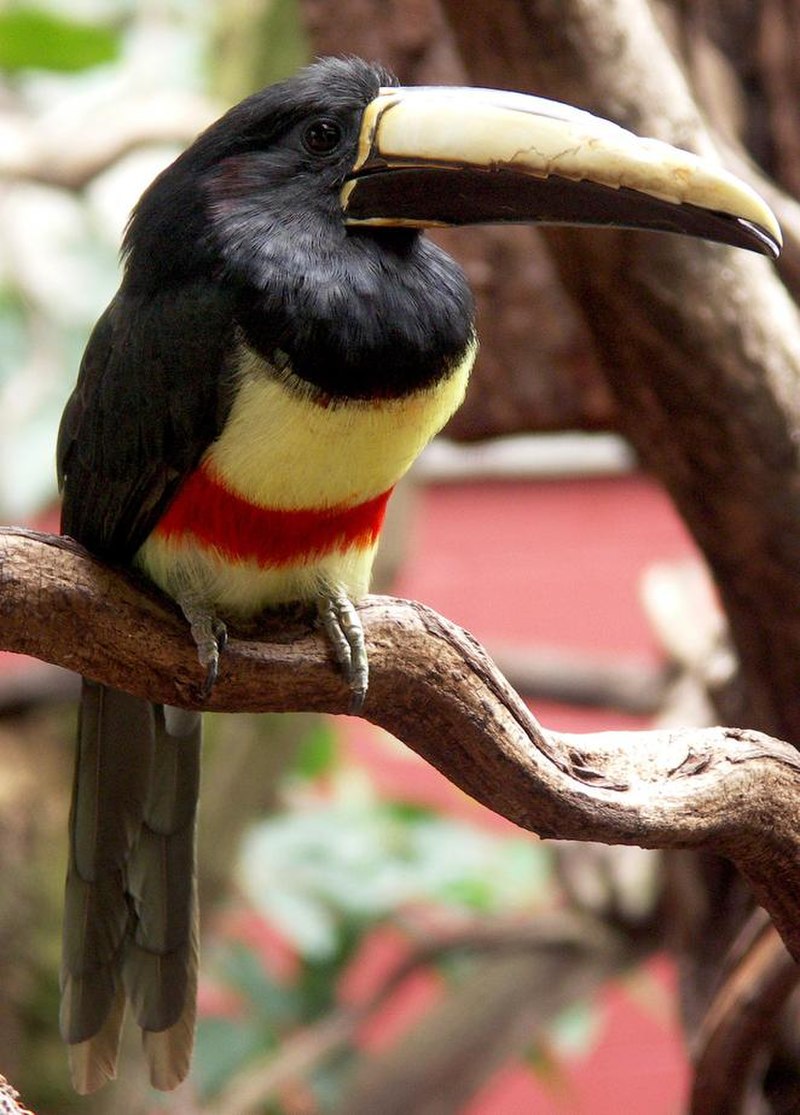
The black-necked aracari is a member of the toucan family found in Venezuela, Brazil, French Guiana, Guyana, and Suriname.
First described by Carl Linnaeus in 1758, it is a near-passerine bird that is also known as the black-necked araçari.
This bird has a black neck and head and can be found foraging for its primary diet of fruit and insects in the canopy of the rainforest.
Like other toucans, it has a distinctive bill which is used for both feeding and communication.
While the black-necked aracari is not considered to be a threatened species, loss of habitat due to deforestation is a growing concern for the future of this remarkable bird.Scientific classification:
| Kingdom | Animalia |
| Phylum | Chordata |
| Class | Aves |
| Order | Piciformes |
| Family | Ramphastidae |
| Genus | Pteroglossus |
| Species | P. aracari |
50. White-Bellied Piculet
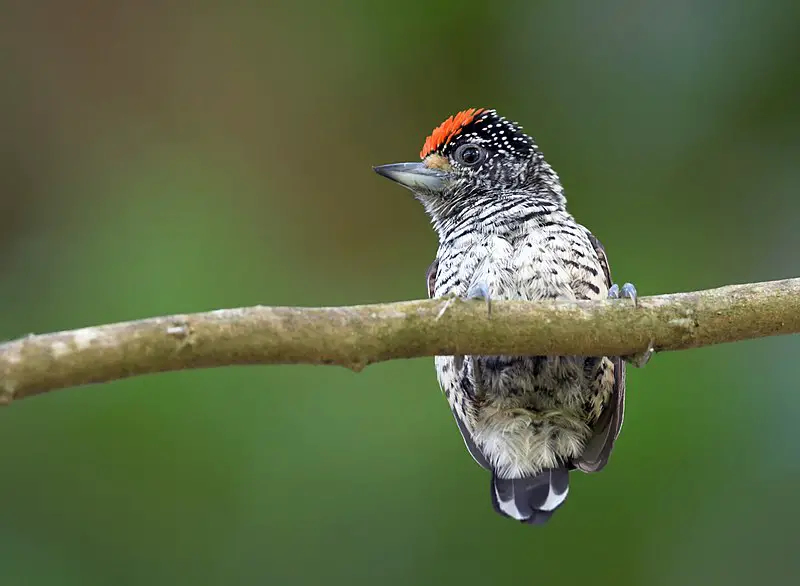
The white-bellied piculet is a Vulnerable bird species found in Brazil, Guyana, and Venezuela. It belongs to the woodpecker family Picidae and subfamily Picumninae.
This bird has three subspecies and was formerly known as P. leucogaster. It has also been considered a synonym of the arrowhead piculet (P. minutissimus).
Despite being classified as Vulnerable, the population status of the white-bellied piculet is currently unknown.
Habitat loss and degradation are likely threats to this species, as it prefers lowland forests and forest edges.
More research is needed to determine the population size and potential conservation actions for this unique bird.Scientific classification:
| Kingdom | Animalia |
| Phylum | Chordata |
| Class | Aves |
| Order | Piciformes |
| Family | Picidae |
| Genus | Picumnus |
| Species | P. spilogaster |